(2014 – 2016) Porsche 911 GT3 (991.1) – Ultimate Guide
Official photos: 2013 March 4 / Premiere: 2013 March 5, Geneva motor show / Market launch: 2013 August
The sportiest 911 will made its world premiere at the Geneva International Motor Show: the new Porsche 911 GT3. In the 50th anniversary year of the 911, Porsche opened a new chapter in race track performance sports cars. The 991.1 GT3 wasn’t without controversy. The famous motorsport-inspired Metzger engine made way for an all-new 3.8-litre flat-six, while electric power-steering replaced the traditional hydraulic set-up. Most controversially of all, there was no manual box – the GT3 is offered exclusively with a seven-speed double-clutch PDK set-up.
Porsche promised that with the all-new engine, transmission and chassis, this model extends the breadth of the GT3’s abilities, allowing for more sophisticated day-to-day use, while retaining the driver engagement and track-bred handling it’s famous for.
The new 911 GT3 kept all the successful properties of a sports car suitable for racing, with even more driving dynamics, more sophisticated practicality – and a highly emotional fun factor. The powertrain of the new 911 GT3 is composed of a 3.8-liter boxer engine yielding 475 hp (350 kW) at 8.250 rpm, a Porsche dual-clutch transmission (PDK) and a high-traction rear-wheel drive. The six-cylinder engine is based on the same engine as the 911 Carrera S, although they share only few common parts. All other components, particularly the crankshaft and valve gear, were specially adapted or designed for the GT3. For instance, Porsche designed titanium connecting rods and forged pistons. The basic modifications set the stage for an extremely high-speed engine that reaches up to 9.000 rpm. The Porsche dual-clutch transmission was also specially developed; the characteristics are directly based on a sequential gearbox from motor racing, thereby providing further performance and dynamics advantages to the driver.
Autoexpress: On the move, the upgrades are immediately apparent. With a short throttle travel, the engine is fast and incredibly free-revving. Power builds relentlessly and rapidly, taking a noticeable step up at 7,200rpm, and racing to the 9,000rpm red line. Acceleration from 0-62mph takes a seriously impressive 3.5 seconds.
For the first time, Porsche is using active rear wheel steering in order to achieve even higher precision and lateral dynamics. Depending on the speed, it steers in the same or opposite direction of the front wheels, improving stability and agility. Other new modules improving driving dynamics are the electronically controlled, fully variable rear differential lock, and the dynamic engine mounts. The newly developed all-aluminium chassis can still be adjusted by height, toe and camber. Contact with the road is made by the new 20-inch forged alloy wheels with central locking.The 911 GT3 is based on the light, yet stuff body of the current generation 911 Carrera in hybrid steel-aluminium construction, however, it comes with independent front and rear parts. In addition, the 911 GT3 is 44 millimetres wider than a 911 Carrera S in the area of the rear axle. Another clear recognition feature is again the large, fixed rear wing. This makes a decisive contribution to the exemplary aerodynamics of the new 911 GT3, which combines low air resistance with even more power.
Autocar: Latest 911 GT3 is big and brutal; despite this Porsche has made it faster, more responsive and more user-friendly than ever
As a result, the new 911 GT3 sets new performance records. At full acceleration from standstill, the 100 km/h mark is breached after 3.5 seconds, and 200 km/h are reached in less than twelve seconds. The top speed is 315 km/h in the seventh, top gear of the completely newly adapted PDK transmission. The lap time on the Nürburgring Nordschleife, which the new 911 GT3 manages in under 7:30 minutes, is even more impressive.
Before the production of the 991 GT3 started in 2013, the number of GT3 cars of the 996 and 997 generations made between 1999-2012 was 14.145! In 2013, on March 5 at the Geneva Motor Show, 991 GT3 & GT3 Cup launch. Persons featured in the video include Andreas Preuninger, Jacky Ickx and Michael Mauer (Director Porsche Style).
Technical specification and comparison
| Modification | 2013 911 991 GT3 3.8 | 2011 911 991 Carrera S 3.8 WLS | 2011 911 997 GT3 RS 4.0 |
2009 911 997 GT3 3.8
|
| No. of seats | 2 | 4 | 2 | 2 |
| Gearbox | PDK 7-speed | PDK 7-speed | manual 6-speed | manual 6-speed |
| kW | 350 | 316 | 368 | 320 |
| lb-ft | 324 | 324 | 338 | 316 |
| Nm | 440 | 440 | 460 | 430 |
| 60 mph | 3.3 sec. | *3.8 sec. | 3.8 sec. | 3.9 sec. |
| 100 km/h | 3.5 sec. | *4.0 sec. | 3.9 sec. | 4.1 sec. |
| 100 mph | 7.5 sec. | |||
| 200 km/h | 11.4 sec. | 11.9 sec. | 12.3 sec. | |
| mph | 196 | 190 | 193 | 194 |
| km/h | 315 | 306 | 310 | 312 |
| kg | 1430 | 1415 | 1360 | 1395 |
| lb | 3153 | 3120 | 2998 | 3075 |
| W/lb | 111 | 101 | 123 | 104 |
| W/kg | 245 | 223 | 271 | 229 |
| Nordschleife | 7:25 | 7:27 |
The many questions
The 991 GT3 came with more questions than answers. Why isn’t the “lightweight 911″ light? Why isn’t the manual gearbox available? Why does it have 20″ wheels, when it is proven that 18” is optimal for racing use…
Engine
The new 3.8-litre GT3 engine was a technological marvel. As there are rules and therefore restrictions for the racing cars, the street-legal 991 GT3 had more power than the 991 GT3 Cup car. Both had 3.8-litre engines, but the racing variant had 338 kW compared to the street version’s 350 kW. The street engine had a rev limiter set 500 revolutions higher, at 9000 rpm instead of 8500 rpm in the Cup car. Although not as powerful, the racing version was naturally much-much lighter.
Engine problem on early cars
Porsche press release from March 19, 2014, said the engines of the first 785 produced 991 GT3 will be replaced by the Porsche Centres. They found the engine could be damaged by the loosened screw joint on the connecting rod, leading to engine destruction and oil getting on hot exhaust which could start a fire.
Gearbox
Even though the GT3 version of the PDK gearbox was 2 kg/4 lb lighter than the PDK in the Carrera, the car suffered 18 kg/40 lb weight increase due to the automatic transmission. The PDK came with a “paddle-neutral” feature – if the driver pulled both shift paddles simultaneously, both clutches were opened and the flow of power from engine to real wheels was cut off.
Rear axle steering
The 991 GT3 was 70 kg/154 lb heavier than the preceding 997 GT3 RS 4.0 and to cope with the weight, rear axle steering was used. At speeds of up to 31 mph/50 kmh, the system steers the rear wheels into the opposite direction of the front wheels, between 31-50 mph/50-80 km/h, the rear wheels are not steered and at speeds above 50 mph/80 km/h, the system steers the rear wheels parallel to the front wheels, so the car can easily change lane going sideways.
Tyres
The 991 GT3 was equipped with Dunlop Sport Maxx Race tyres, a new alternative to the Michelin Pilot Sport Cup tyres. The sizes were 245/35 ZR20 (91Y) N0 and 305/30 ZR20 (103Y) XL N0. “N zero” says a tyre is created specifically for Porsche.
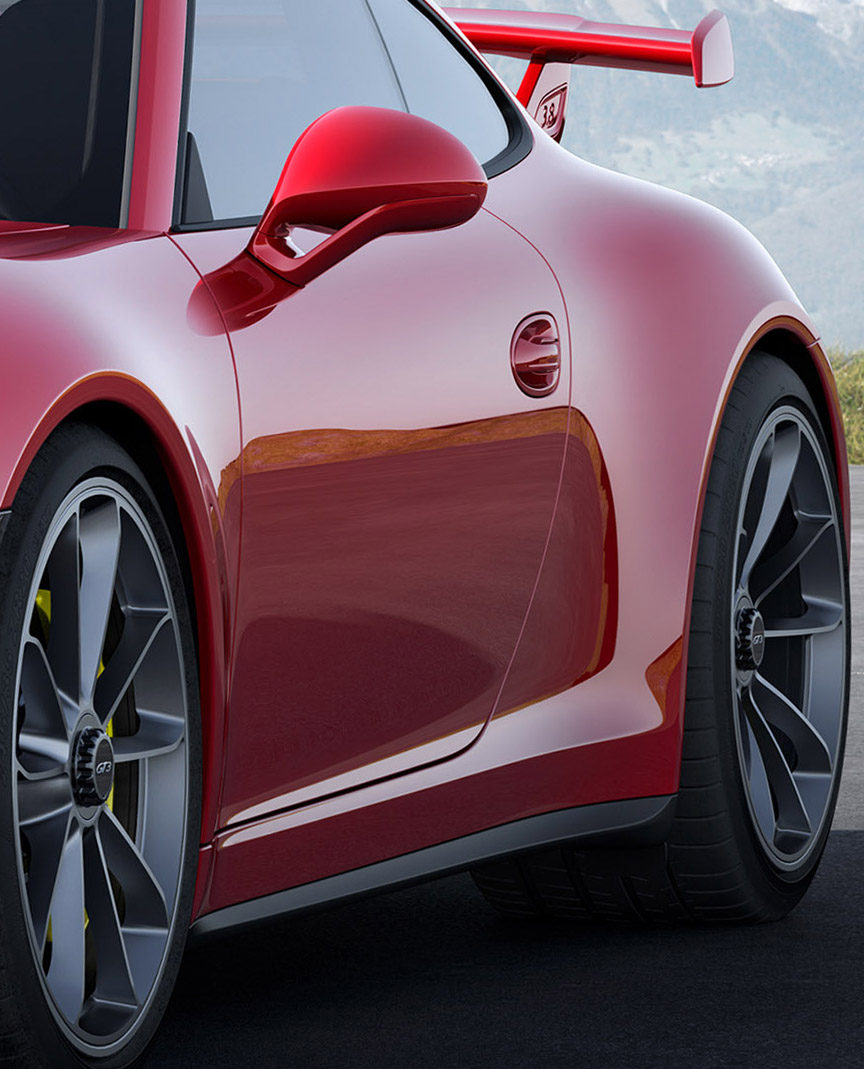
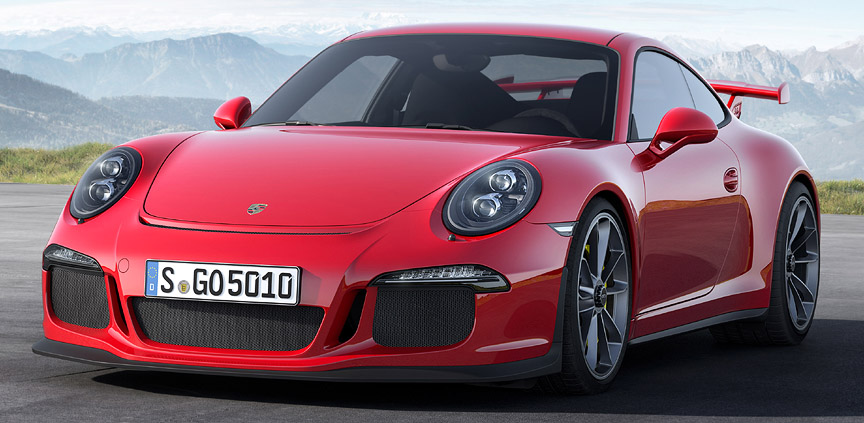
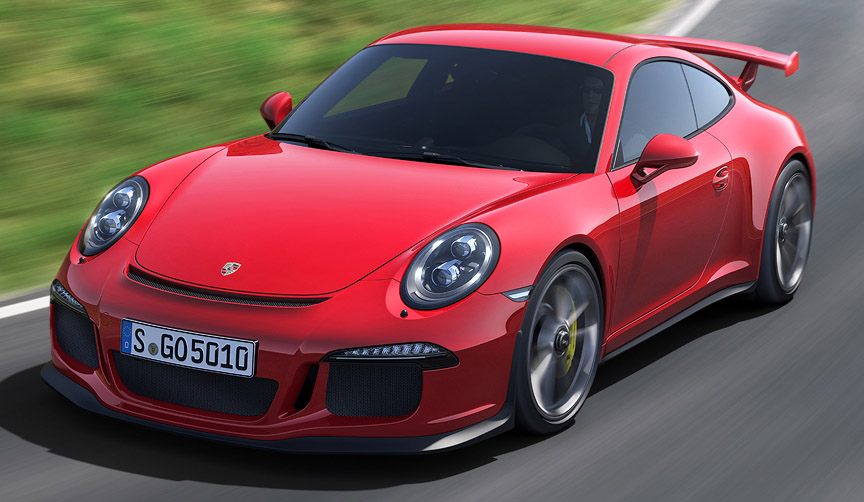
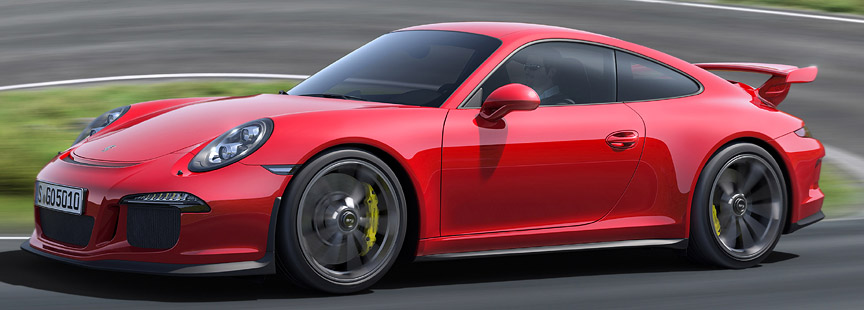
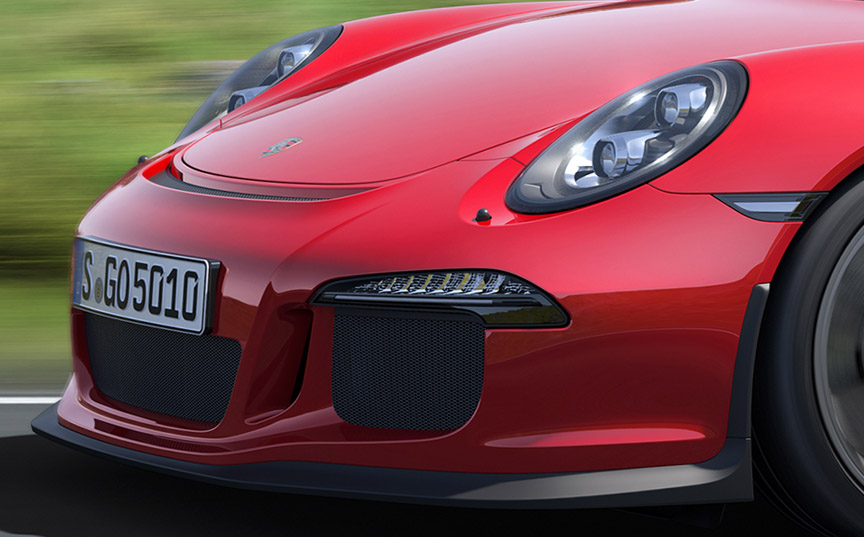
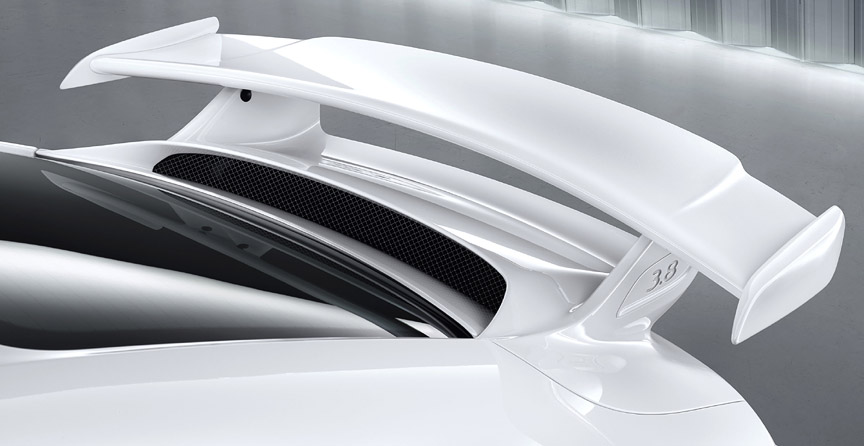
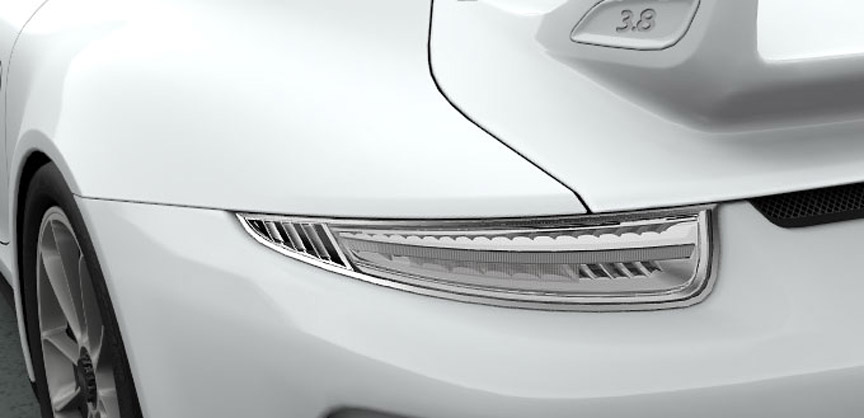
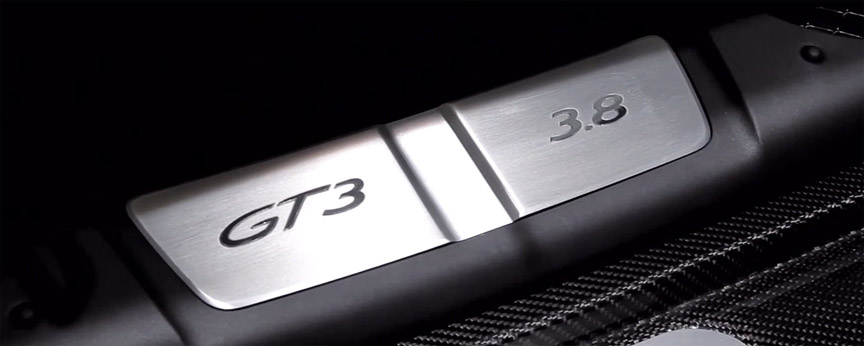
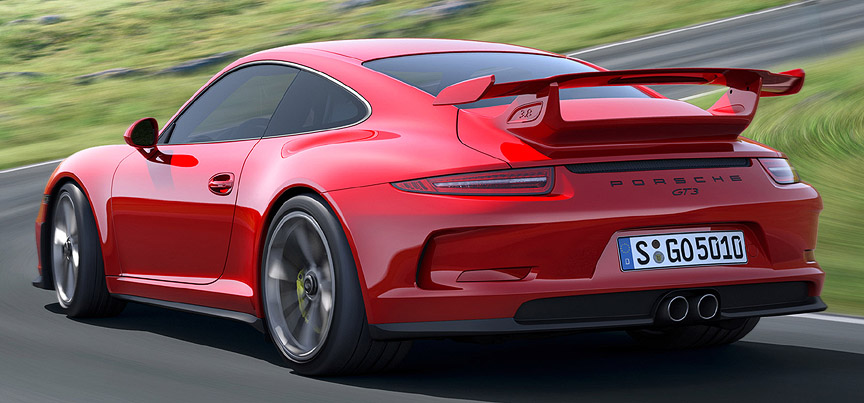
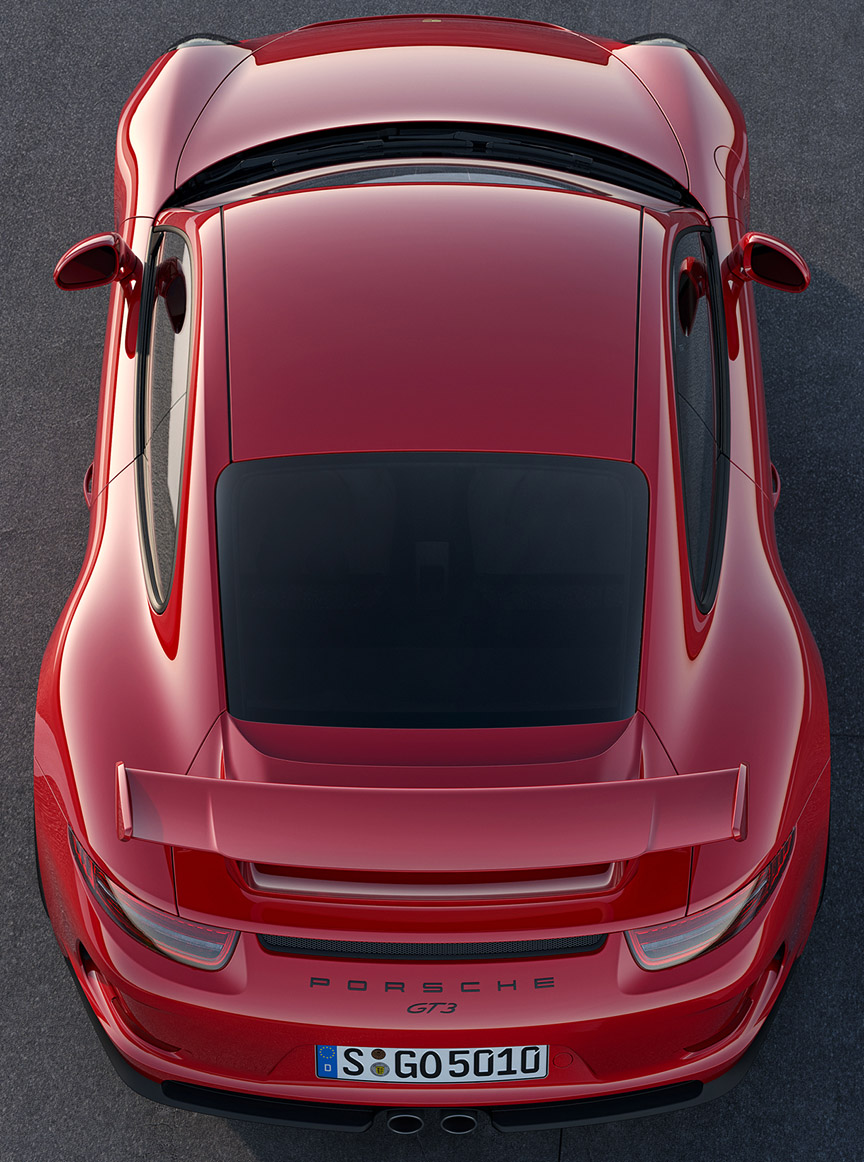


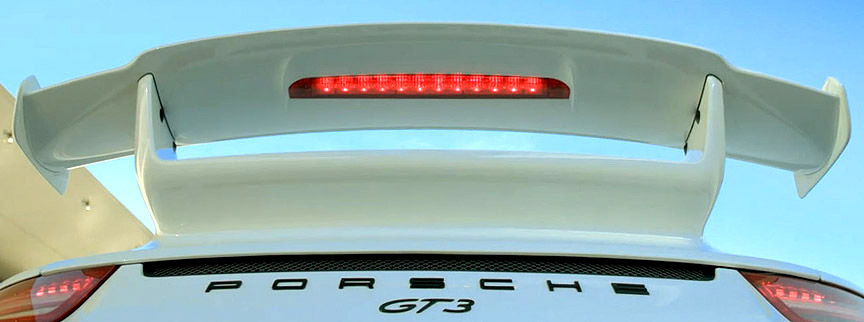
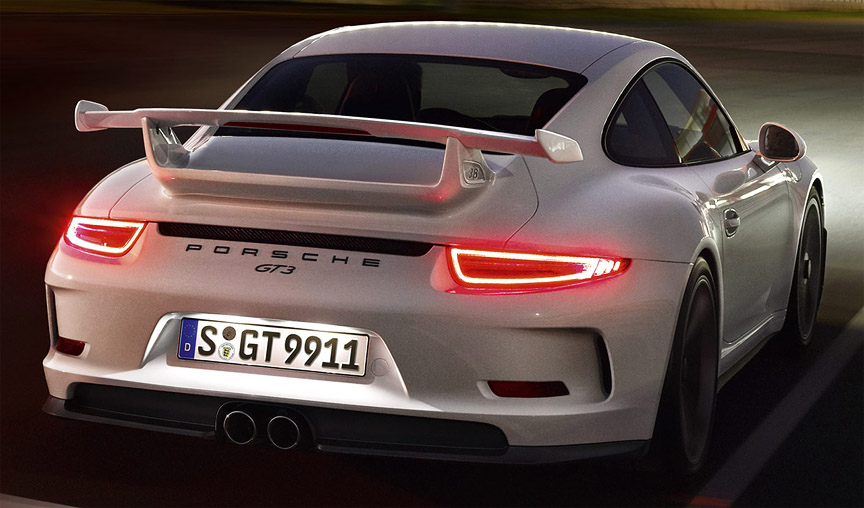
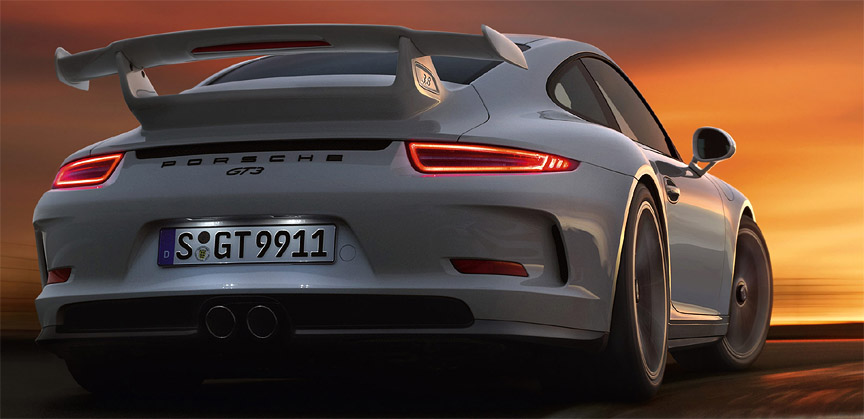


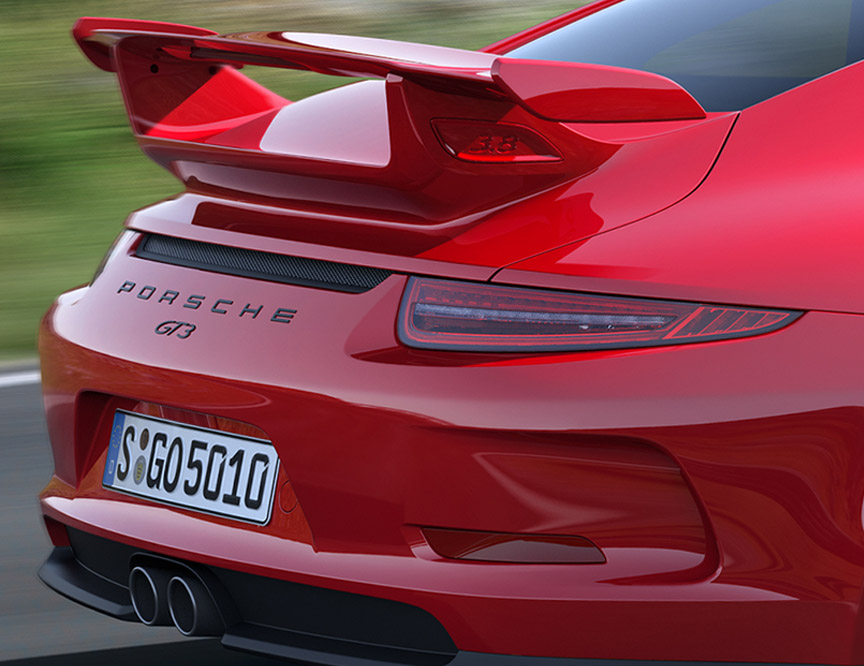
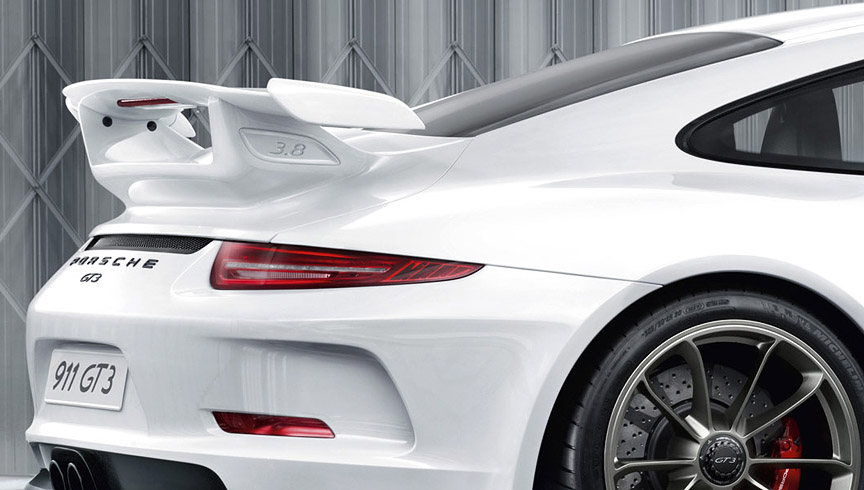
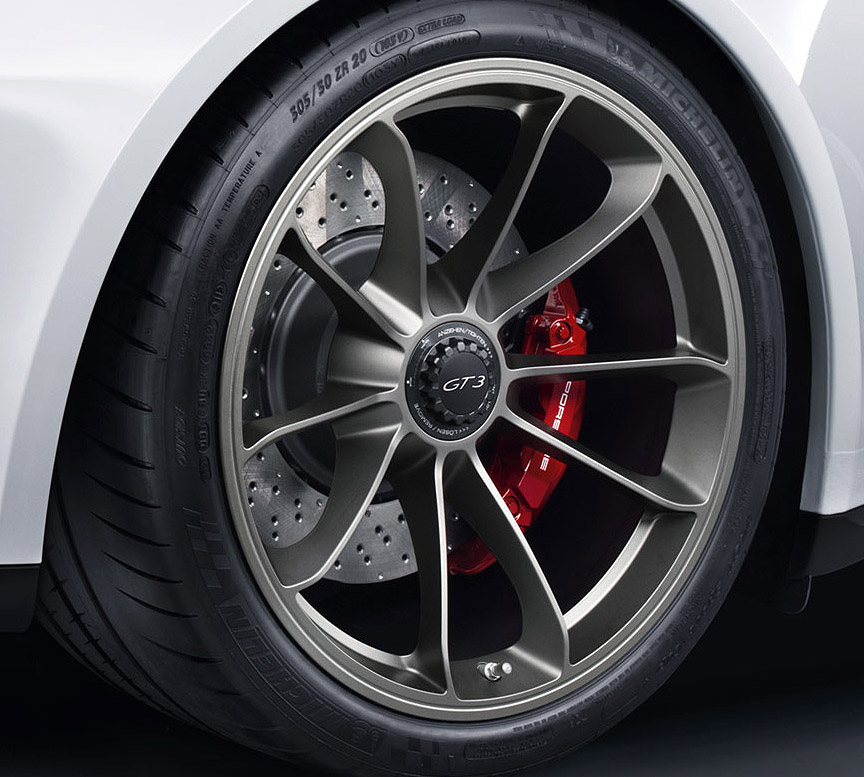
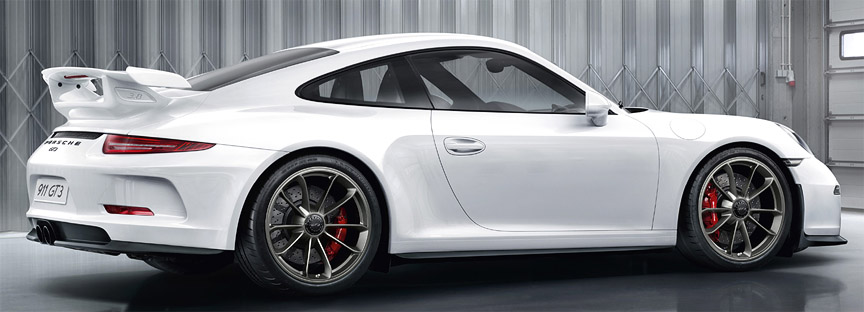
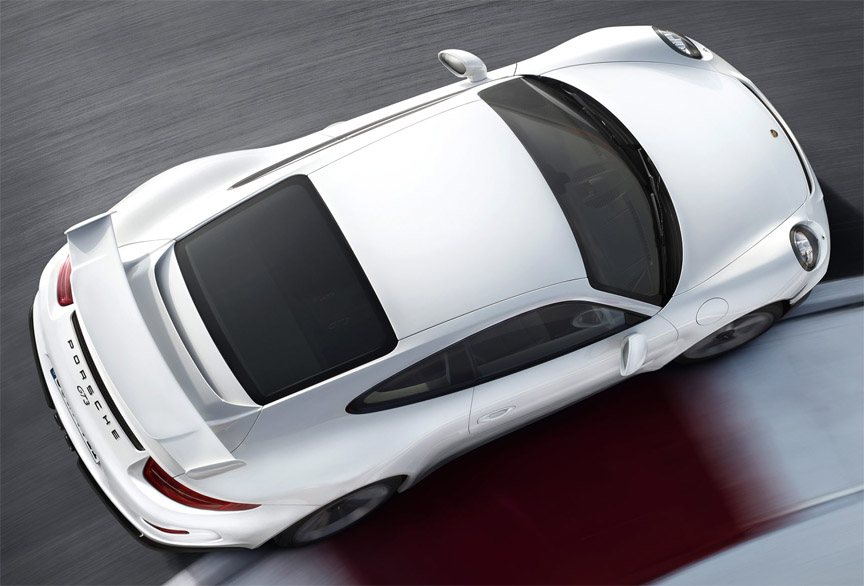
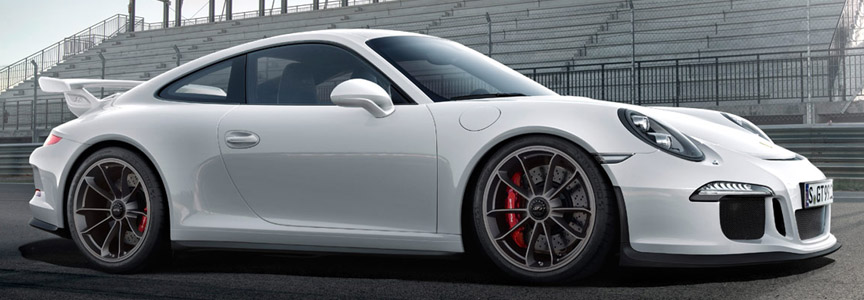

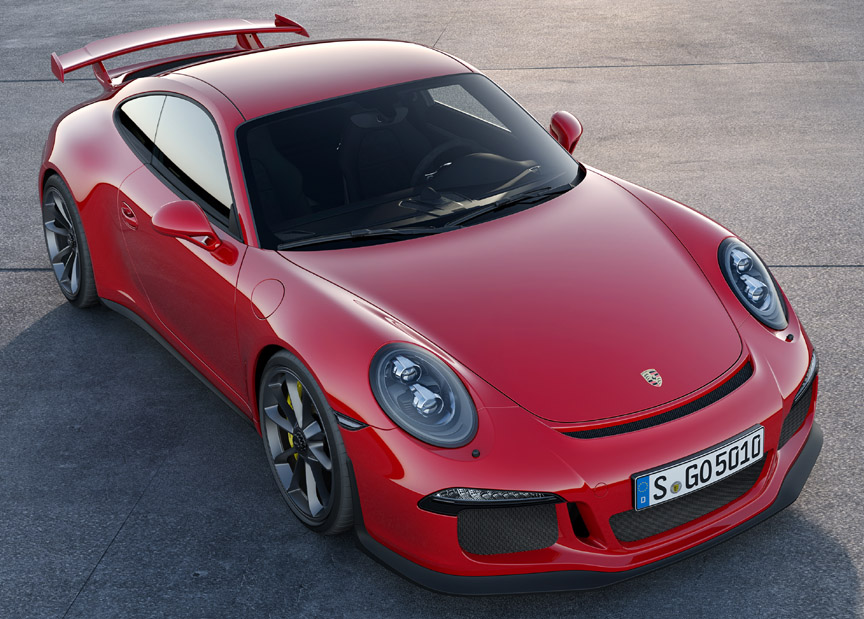
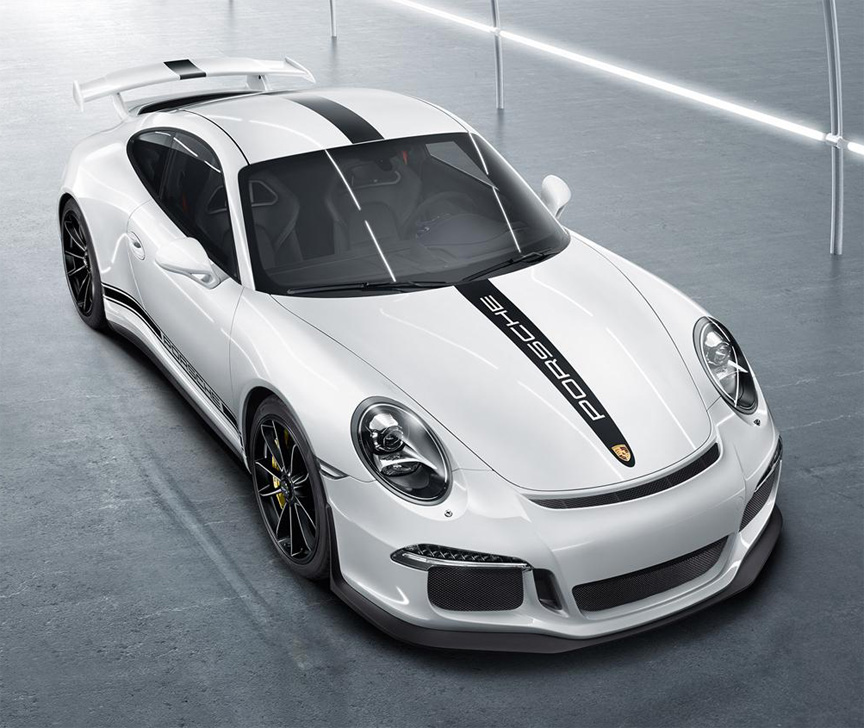
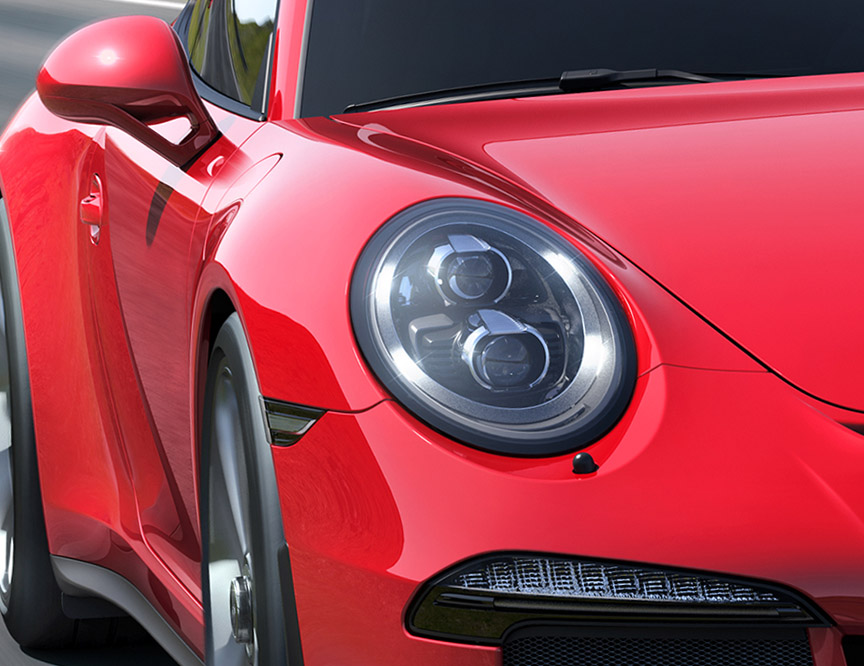
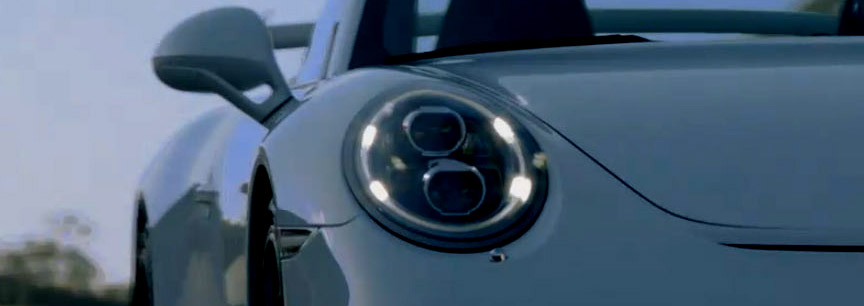
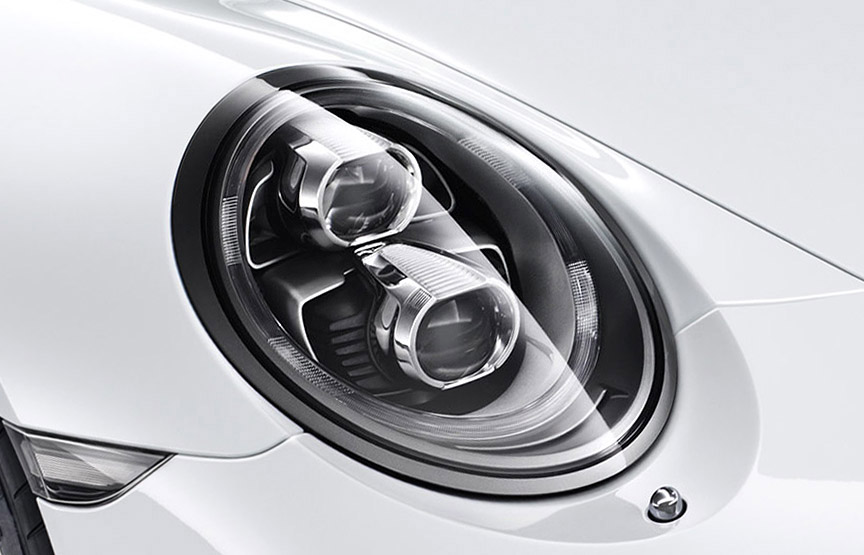


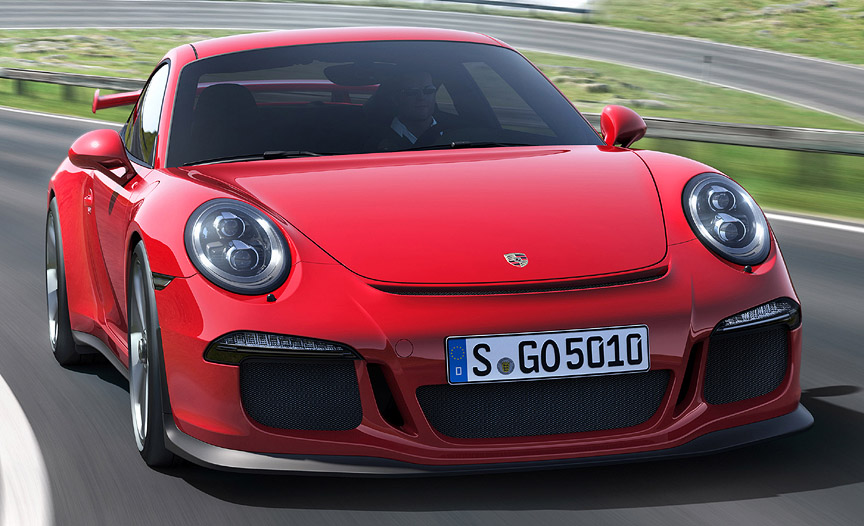
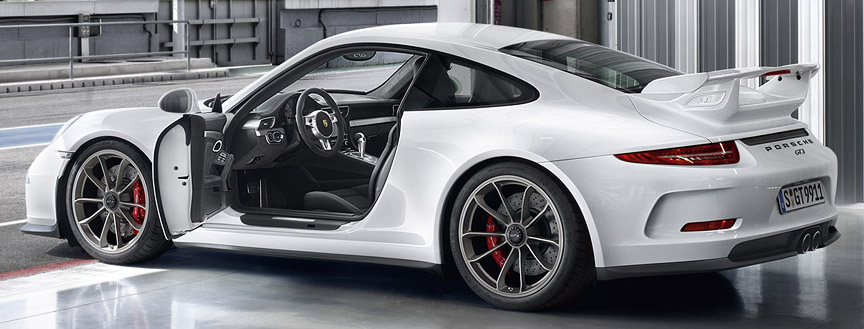
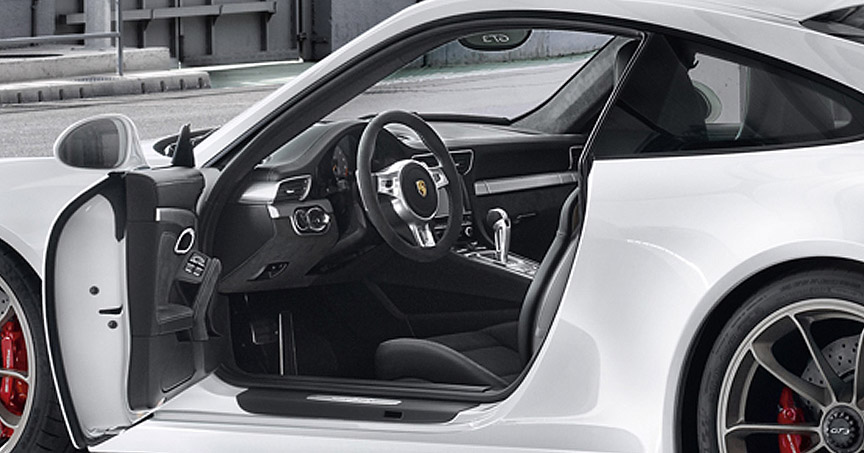
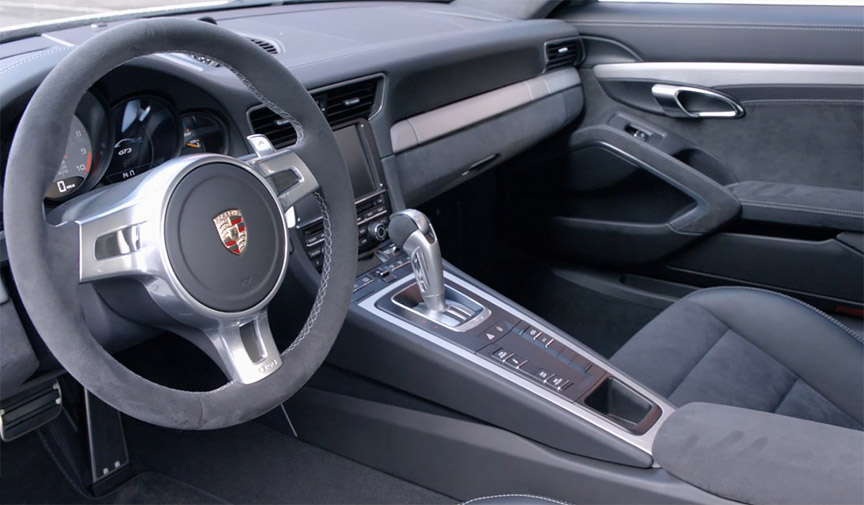
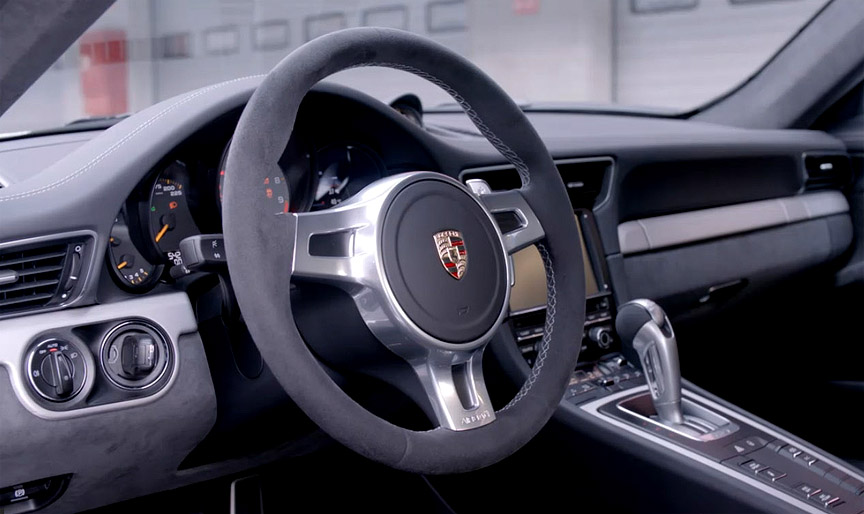
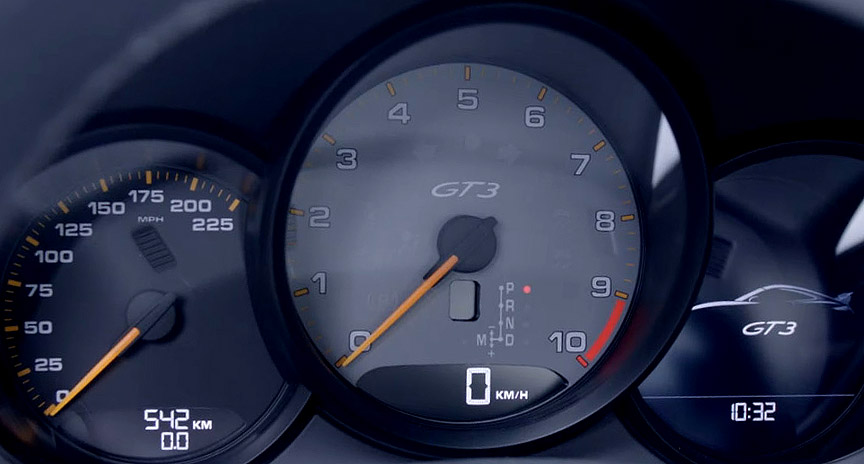
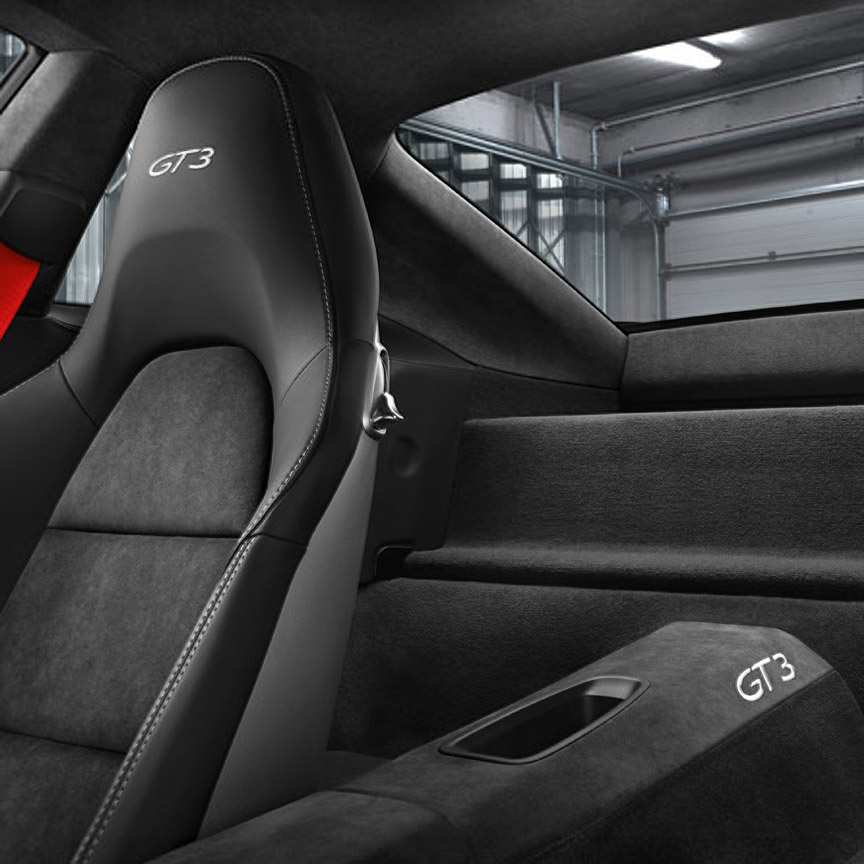
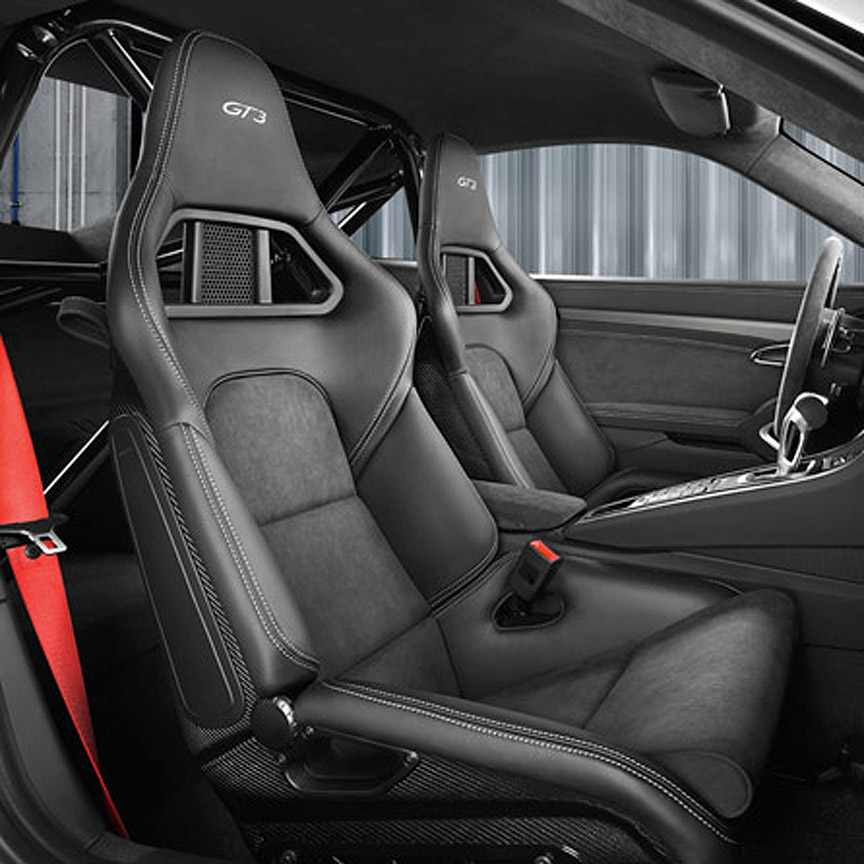
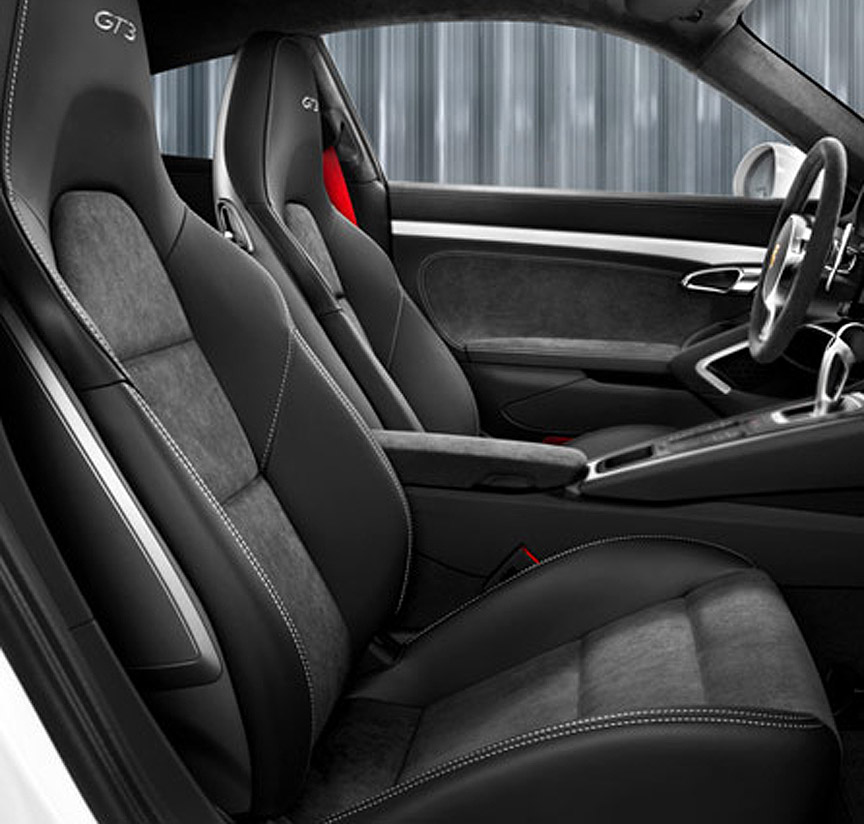
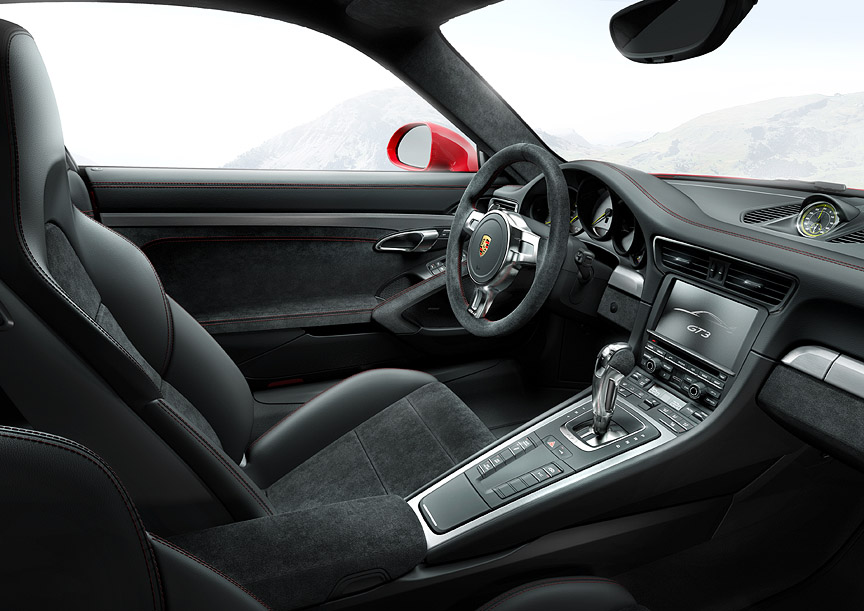
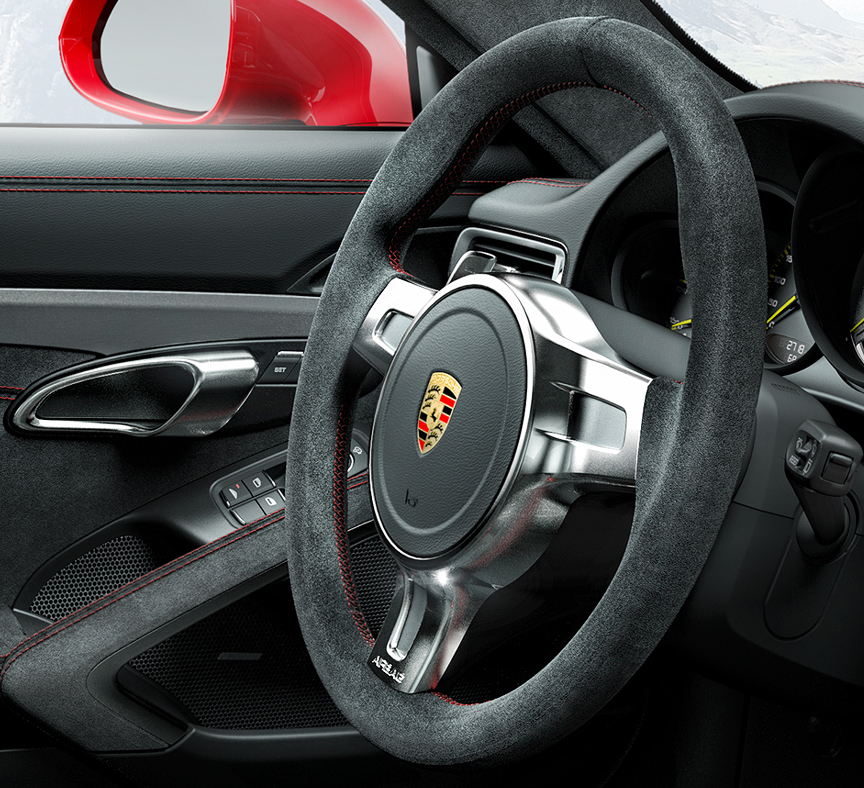
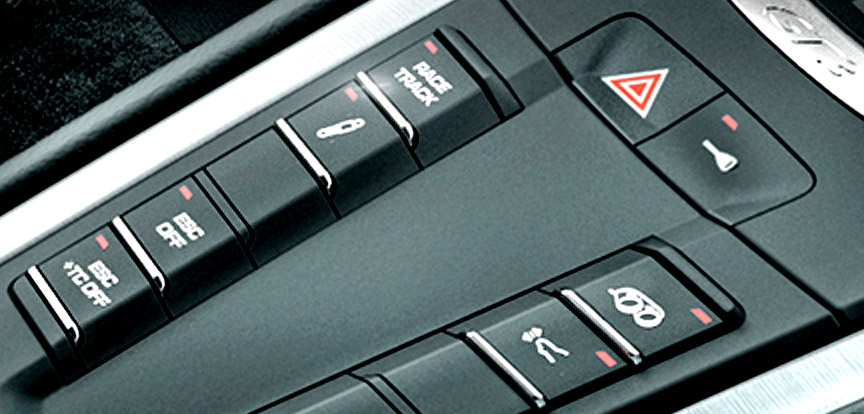
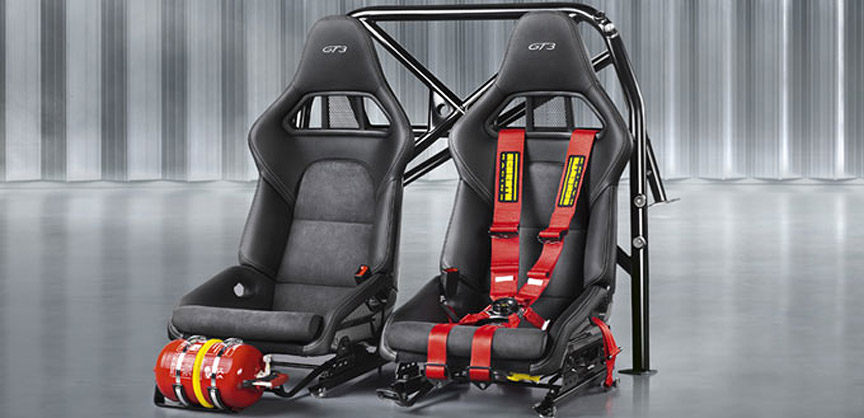
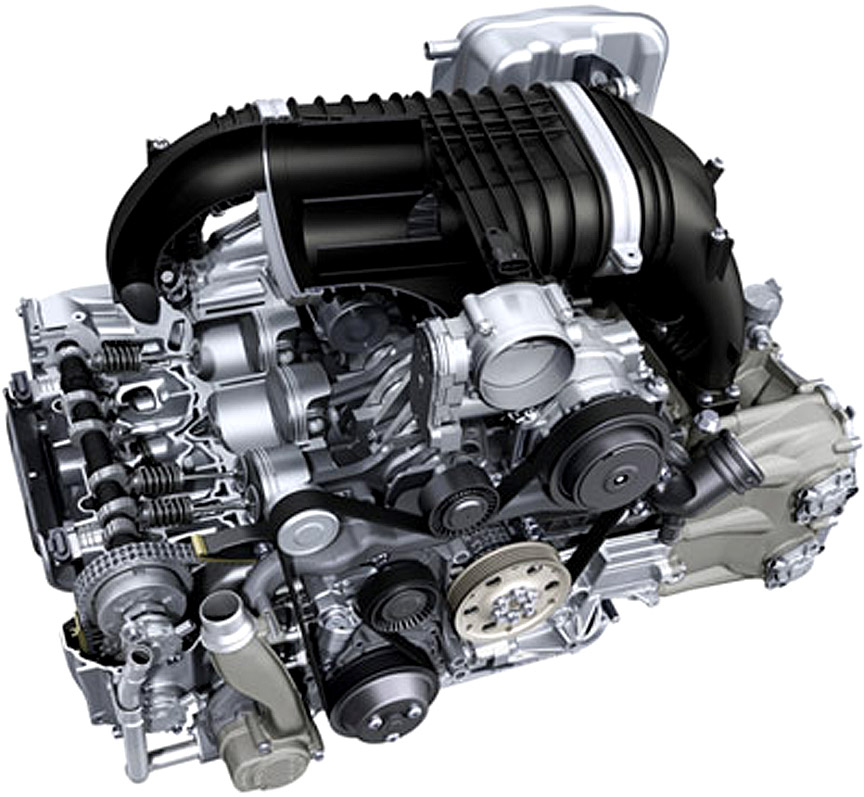
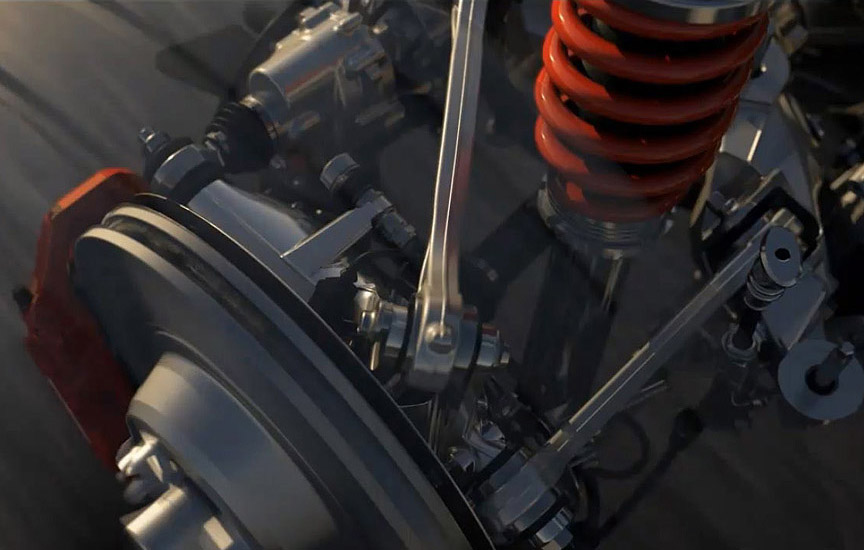
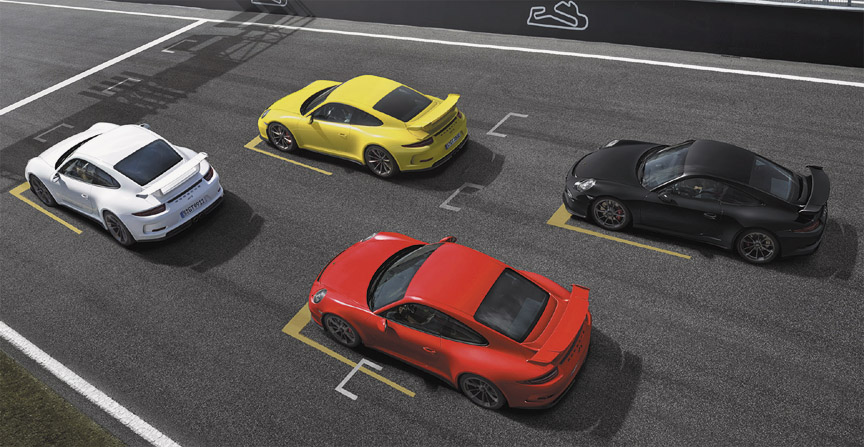
Pictures
The Video Reviews
Press Release
Every Porsche has a race car at its heart. And never was the close relation to car racing so tangible. The new Porsche 911 GT3 stands for a redefined, even more emotional driving experience. The sports car that was developed from scratch offers even more dynamism and refined everyday practicality at the highest level.
With the GT3, Porsche is marking this 911 anniversary year by opening a new chapter in the area of high performance sports cars for circuit tracks. Both engine and transmission, as well as body and chassis are entirely new, and extend the 911 GT3 concept with an impressive performance leap. This is due to the new active rear-wheel steering, and the GT3-specific Porsche dual-clutch transmission with the characteristics of a sequential gearbox used in motor racing. Following the total production of 14,145 GT3 cars since 1999, the fifth generation of the 911 GT3, an all-round redevelopment, is set to take on the pole position among the thoroughbred Porsche sports cars with naturally aspirated engines.
The mission of the Porsche 911 GT3 is unmistakable: driving dynamics. Each and every relevant detail has been fine-tuned to that. The result is impressive: the new 911 GT3 laps the Nürburgring Northern Loop, indisputably the most challenging race track in the world, in a mere 7:25 minutes. A benchmark of great significance for the sportiest 911 with a naturally aspirated engine. Because around 80 percent of all 911 GT3 vehicles are also driven on race tracks.
Drive system and chassis of the new 911 GT3 have been systematically developed to even better performance, precision and transverse dynamics. Additionally, Porsche is using active rear-wheel steering for the first time. Depending on the speed, the system steers in the opposite or the same direction as the front wheels, thereby improving agility and stability. Among the other new driving dynamics features are the electronically controlled, fully variable rear differential lock, and the dynamic engine mounts. The height, toe and camber of the newly developed all-aluminium chassis are still adjustable. The new, 20-inch forged alloy wheels with central locking are used for optimal road contact.
New high-performance drive system with cutting-edge technology
Porsche has developed an entirely new engine for the 911 GT3. For the first time, the classical six-cylinder naturally aspirated engine has direct petrol injection in the racing car-like 911, combined with high-performance elements such as dry sump lubrication, titanium connecting rods and forged pistons.
In combination with valve control by rocker lever, an extremely high-revving engine capable of reaching up to 9,000 rpm emerged. For the driver, this means an even broader engine speed range that can bring decisive time advantages on the race track. The speedy response of the drive system is enhanced by the new power transmission without any interruption in propulsive power. As the first 911 GT3, the new model has a Porsche Doppelkupplung dual-clutch transmission (PDK) that had been originally developed for racing and has now made a comeback in a perfected form. The PDK is another feature specially developed for the 911 GT3, with characteristics directly inspired by the sequential gearboxes used in motor racing, thus granting the driver further benefits when it comes to performance, dynamics and driving fun.
Fascinating sports engine with high-revving concept
The new engine of the Porsche 911 GT3 is based on the six-cylinder used in the current 911 Carrera generation. The structural changes to the base engine had one principal goal: to develop the characteristic 911 GT3 high-revving concept further. High speeds enable high performance and gear changes, whereby the revolutions remain in the range of maximum power after shifting up. Thus the six-cylinder reaches its maximum performance of 475 hp (350 kW) at 8,250 rpm; the nominal torque of 440 Newton metres (Nm) is available at 6,250 rpm. The consistent development focus made it possible to increase the maximum speed to 9,000 rpm. This enables the 911 GT3 to reach peak performance values among street-legal vehicles. The result is a drive system that ventures even further into the racing range than ever before with a litre performance of 125 hp per litre.
With its low moving masses, the engine develops high speed dynamics. Thus the new 911 GT3 does not only feature an enormous revving capacity but also an excellent response across the entire engine speed range. These features ensure a particularly sporty driving experience in all conditions.
Special cylinder heads with rocker arm control from motor racing
The focus of the new development were the cylinder heads, which differ fundamentally from those of the base engine, and were specifically developed for the 911 GT3. To enable peak performance values and engine speeds, the new cylinder heads are equipped with large intake and exhaust ports, large valves, and separate valve control with rocker arm. Cooling and oil supply are also particularly powerful to account for the high loads.
The valve actuation via rocker arms with hydraulic valve clearance compensation is another unique feature. The concept embodied in the Porsche 911 GT3 engine originates from racing and allows very high engine speeds on the one hand, while the other cams with performance-oriented profiles permit for large strokes and long valve opening times. The advantage of the rocker arm control is mainly in the low moving masses that allow high engine speeds, and the large contact area between the cam and rocker arm.
Advanced dry sump lubrication ensures the oil supply
The typically high and frequent lateral acceleration occurring with an ambitious driving style on the race track makes high demands on the oil supply. That’s why the 911 GT3, as previously, has dry sump lubrication, i.e. the oil is siphoned permanently from the oil pan and is stored in a separate receptacle. In addition, the new 911 GT3 engine has for the first time an oil separator, a construction that also originates in racing. The oil separator consists of a cover between the crankcase and the oil pan featuring 18 single holes (three per cylinder) with crescent-shaped blades. Especially with high torques, the splash oil stirred up by the crankshaft is separated at the crescent-shaped blades (“planed”) into the oil pan. Thus the amount of splash oil in the crankcase is lessened and as a consequence the so-called splashing losses of the engine are reduced. Alongside the demand-controlled oil pump, the new 911 GT3 also has two splash oil nozzles per piston that are opened in tandem depending on the temperature, load and torque. This guarantees an intensive cooling of the pistons, which are subject to high thermal loads.
More torque at the press of a button
As was the case with the predecessor, the new 911 GT3 also offers the driver the possibility of increasing the torque in the mid range at the press of a button. When activated, the backpressure in the sports exhaust system is further reduced, improving gas exchange, thus increasing the torque in the 3,000 rpm to 4,000 rpm range considerably again.
Dual-clutch transmission PDK with special 911 GT3 layout
The dual-clutch transmission (PDK) originates from Porsche racing. With the Porsche 911 GT3, it returns to the racetrack: the motor sports engineers have revised the PDK extensively both in terms of mechanics and control technology for the new high-performance sports car.
The resulting transmission provides the driver with all the essential driving dynamics of the previous manual transmission, complemented with the performance benefits of the dual-clutch transmission. During racetrack use, it can therefore be driven much like a sequential manual gearbox – with even more performance and emotional driving fun.
Two modes are available to the driver: manual shifting or the adaptive shift programme. Manual shifting is done using two paddles on the steering wheel, the right for upshifts and the left for downshifts. Shorter shifting travel and optimised actuating force result in even faster gearshifts with concise feedback, similar to the operating characteristics of the 911 GT3 Cup race cars. Alternatively, the driver can also shift using the selector lever, with a shift pattern based on that used in professional motor sports: shifting up is done by pulling the lever back, shifting down by pushing it forward.
Ready for the racetrack: “lighting shifts” with extremely short reaction and gearshift times
Gearshifting strategy and response times of the 911 GT3 PDK were consistently designed for maximum performance, and are fundamentally different from the other Porsche sports cars. This becomes apparent to the driver during manual upshifts in the form of a “lightning shift,” which permits reaction times of less than 100 milliseconds. To enhance driving performance, lighting shifts are implemented with a torque overshoot, and the gear change is conducted with a highly dynamic adaptation of the engine speed to the newly selected gear. The switching times are in a range that was previously reserved for the world of motor sports.
Paddle-neutral: de-clutching function in the 911 GT3 PDK
The dynamics of a sports car driven to optimum lap times is also determined by the clutch. That’s why the PDK comes with a “paddle-neutral” feature. If the driver pulls both shift paddles simultaneously, the clutches of the PDK are opened, and the flow of power between the engine and drive is cut off. Once both shift paddles are released, the clutch engages at lightning speed if the PSM is switched off. With PSM switched on, the clutch is closed quickly, but in a less pulsed manner.
This function offers two principal advantages: the driver can, for example, neutralise the driving behaviour of the vehicle when oversteering in a wet curve by pulling the paddles, thus redirecting additional cornering force to the wheels of the rear axle. The second aspect relates to individual influence of the driving dynamics due to the pulsed onset of the driving force when engaging the clutch. Comparable to a traditional coupling with a manual transmission, the rear of the vehicle can be consciously destabilised for dynamic leaning into the curve. Furthermore, the driver can use the paddle-neutral for accelerating from a standstill. As is the case with manual transmission vehicles, the driver alone decides on how to accelerate using clutch and accelerator foot, without any assistance from drive and dynamic handling control systems.
Adaptive shifting with sports strategies
or the first time, the PDK provides the driver of the new 911 GT3 with the alternative of leaving gearshifting to the adaptive transmission control. In principle, the PDK of the new 911 GT3 comes with two gearshifting strategies: Normal and PDK Sport. This means that the gear changes of the new Porsche 911 GT3 are always fast. Gear shifts and shift points are adapted to the dynamics of the driver.
The PDK Sport mode is activated by pressing the correspondingly labelled button on the centre console. In this mode, the PDK uses shift maps that are tailored to the requirements of pure circuit race track operation. Gears are held longer, and upshifts occur at higher engine speeds. The circuit race track optimisation also entails that the shifting programme is still performance oriented, even at a moderately sporty driving style. The high-performance sports car is therefore always running at the performance-oriented operating points, and increased traction is available at any time without the driver having to shift gears.
Like the latest 911 Carrera models with PDK, the new 911 GT3 possesses the dynamic “Launch Control” start up function for maximum acceleration from a standstill. In the new 911 GT3, this function can be accessed at any time without having to activate another button. Analogous to the 911 Carrera models, the readiness for the acceleration start is displayed in the tachometer of the instrument cluster (“Launch Control”).
Shorter gear ratios
The mechanical changes primarily relate to the internal structure of the PDK. For instance, the use of lighter gears and wheels optimally support the engine speed dynamics of the high-revving motor. Moreover, the total weight of the PDK transmission was thereby reduced by about two kilograms. Shorter gear ratios provide completely new characteristics, meaning that the maximum speed is reached in the seventh and highest gear. In conjunction with the rear axle ratio, which was shortened by 15 percent, the new 911 GT3 therefore comes with significantly shorter gear ratios than the transmission ratios 911 Carrera models – in all gears.
911 GT3 with new rear-wheel steering
The chassis of the new 911 GT3 covers a range of options in terms of vehicle dynamics that is without precedence. The concept is typical for Porsche. Based on a high-precision chassis, the intelligent interaction of active systems is able to adapt the driving characteristics at any time and better than ever to the driving situation.
Especially the new active rear-wheel steering and the Porsche Torque Vectoring (PTV) Plus, used in the 911 GT3 for the first time as standard, expand the range of driving options considerably, completed by active engine mounts, the Porsche Stability Management (PSM) and the active damper system (PASM).
The active rear-wheel steering comprises two electro-mechanical actuators, which are used at the left and right side of the rear axle instead of the conventional control arms. These allow the steering angle of the rear wheels to be varied by up to about 1.5 degrees, depending on the speed. Depending on the turning of the steering wheel, two effects are achieved: if front and rear wheels are steering in the opposite direction, the Porsche 911 GT3 drives like a sports car with considerably shorter wheelbase – even shorter than in the previous mode. With the agility of a go-cart, it enters a bend even more dynamically and is more agile in curves. The system activates this function with speeds under 50 km/h, thus reducing the turning radius, and manoeuvring and parking become much easier in everyday use.
The second effect occurs with the steering of the front and rear wheels in the same direction: the felt wheelbase of the 911 GT3 expands. This results in more stability when changing lanes and an increased driving stability especially at high speeds. What’s more, the side force on the rear axle triggered by the steering input of the driver is built up much faster than with a non-steered rear axle, which leads to a more spontaneous and harmonious initiation of the change in direction. The steering in the same direction takes effect as of a speed of 80 km/h.
This variability means that the rear-wheel steering contributes significantly to resolve the inherent conflict of driving dynamics between agility and driving stability. This results in advantages when it comes to agility, driving safety and practicality, as well as increased driving performance. The rear-wheel drive thus played a decisive role in the further improvement of lap times at the Nürburgring.
Leaving curves with more traction: Porsche Torque Vectoring Plus
Depending on the driving situation, the active rear-wheel steering is supplemented by the Porsche Torque Vectoring Plus. The system consists of an electronically controlled, fully variable locking rear differential and selective braking interventions at the right or left rear wheel on road surfaces with low traction. By turning the steering wheel, the inside rear wheel is slowed down slightly. This gives the outside rear wheel more driving force and enables an additional momentum in the steered direction. The result is a direct and dynamic turning in the bend. At low and medium speeds, the PTV Plus thus significantly increases both agility and steering precision.
At high speeds or when accelerating out of the bend, the locking rear differential takes effect and provides additional driving stability. Unlike the previous model that had a rear differential lock with fixed locking values, the electronically controlled locking rear differential in the new 911 GT3 can be controlled fully variably and actively independent of the driving situation on account of the deployment of the PDK transmission. That means that, especially when pushing the driving dynamics boundaries, the fully variable locking rear differential offers even greater traction, boosted transverse dynamics and significantly increased driving stability under changing loads when cornering and performing lane change manoeuvres. Another advantage of the fully variable locking rear differential is improved braking behaviour while full braking. In the process, the complete unlocking of the differential enables an optimum activation of the individual wheels with an ABS braking manoeuvre and thus a stable and efficient braking process with greatest possible deceleration.
PSM for the race track that can be deactivated in two stages
PTV Plus complements the Porsche Stability Management (PSM) that also has an influence on the driving dynamics, among other things by means of braking intervention on individual wheels. As with the predecessor model, the vehicle stabilisation system in the 911 GT3 has an especially sporty setup. Thus the Porsche Stability Management (PSM) with sporty tuning can be fully deactivated in two stages via the two functional scopes ESC OFF and ESC+TC OFF in the new 911 GT3 as well.
So the PSM offers a scope of influence on individual driving dynamics to drivers who prefer an extremely sporty driving style also in the 911 GT3. The new Porsche 911 GT3 has been specially tuned to an even more precise and sensitive control. In its basic setting, the PSM provides a high level of pre-emptive safety. In terms of longitudinal dynamics, by means of the Traction Control (TC) with the sub-functions of ABD (Automatic Brake Differential), ASR (Traction Control) and MSR (Engine Braking Control) as well as ABS (anti-lock braking system). In terms of lateral dynamics, by means of Electronic Stability Control (ESC), predominantly through braking interventions on individual wheels with severe oversteering or understeering of the vehicle.
During the first deactivation stage, “ESC OFF,” the possible driving dynamics on race tracks are increased by the deactivation of the ESC transverse dynamics control. With it, the driver can purposefully destabilise the rear of the 911 GT3 in bends by means of corresponding steering movements and/or control of the accelerator pedal. The sporty functions for longitudinal dynamics control are maintained in this driving mode. In the second deactivation stage “ESC+TC OFF,” all dynamic handling control systems except the anti-lock braking system are deactivated. The driver has sole control and is able to realise his individual racing-inspired driving style.
PASM with expanded spread of adaptive damping
The damping in the 911 GT3 also remains actively controlled with the aid of the specially tuned variable damping system PASM. As was the case with the predecessor model, the driver can choose from two maps. The Normal Mode controls the damping in a sportily taut manner for driving on public roads and on circuit race tracks with uneven surfaces such as the Northern Loop. In order to boost the dynamic potential of the new 911 GT3 even more, in particular on circuit race tracks, PASM in the Sport Mode enables a specially precise and targeted driving behaviour by means of reducing body motions to a minimum. On account of advanced control algorithms, the new 911 GT3 offers a spread of the adaptive damping function both in the Normal Mode and the Sport Mode that is even wider than that of the predecessor model.
As with the predecessor model, a pneumatic lift system on the front axle is offered in the 911 GT3. With new individual components, this again provides the option in the new Porsche 911 GT3 to increase everyday usability significantly by lifting the body by 30 millimetres in the front at speeds of up to 50 km/h. This way, any damage to the body caused by rough bumps in the road surface can be prevented.
Dynamic engine mounts prevent disturbing mass impulses from the engine
Porsche uses another active system for the improvement of driving dynamics in the new 911 GT3: standard dynamic engine mounts. The controller uses the present 911 GT3 sensors to detect a racing driving style, and hardens the normally elastic engine mount. For this purpose, the bearings are filled with an enclosed liquid with magnetic particles, which changes in viscosity in the presence of an electric field.
This keeps the GT3 comfortable in everyday life; on the circuit racetrack, on the other hand, disturbing mass impulses from the engine during cornering are compensated. Another advantage is the improved traction when accelerating from a standstill. In the new 911 GT3, the maps of the dynamic engine mounts are pre-selected via the button for PASM control.
Tyre Pressure Monitoring with new circuit race track mode
Furthermore, the Tyre Pressure Monitoring System (TPM) was enhanced by the auxiliary function of circuit race track mode that also adds to the gain in driving dynamics of the new 911 GT3. Principally, the air temperature and thus the pressure in the tyres is increased with the intensified driving on the race track. An increase of the air temperature in the tyre by 50° C, equalling an increase of the pressure by around 0.5 bar, is not unusual.
With the increased pressure, the running surface of the tyre is deformed and the contact area with the road reduced. The pressure has to be adjusted so as to achieve the largest-possible contact area and thus the best performance. In order to ensure a precise pressure monitoring even on the circuit race track, however, the circuit race track mode enables the individual adjustment of the tyre target pressure. The setting is done on the instrument cluster via the “Tyre pressure” menu. Once the race track mode has been activated, a stylised circuit race track with a yellow “R” is permanently displayed on the screen of the instrument cluster. It gives orientation to the driver, so that he switches on the standard monitoring function with pre-set pressure values when driving on public roads again.
Further increase in braking power, new ceramic brakes optional
Quintessentially Porsche: in the new 911 GT3, more dynamic driving performance goes hand in hand with further improvements in braking performance. At the rear axle, larger braking discs with a 380 mm diameter are used, the ventilation holes of the discs have been redesigned, and cooling was improved by ways of additional brake cooling ducts on the rear axle. To reduce unsprung weight, the new Porsche 911 GT3 comes with racing-derived composite brake discs with friction rings made of cast iron and aluminium pots, just like its predecessor. The two components are connected by stainless steel pins.
Parallel to the standard brake system, the performance of the optional ceramic brake system Porsche Ceramic Composite Brake (PCCB) has been improved. The diameter of the ceramic brake discs have been increased from 380 millimetres to 410 millimetres on the front axle, and from 350 to 390 millimetres on the rear axle. This increases the effective friction surface on the front axle by around 14 percent, on the rear axle by roughly 20 percent. By dint of a significant increase of the amount of ceramic in the carbon-fibre composite, the wear resistance of the new disc generation could be significantly increased even under especially high loads.
Big wheels with less weight and more contact area
The wheels, developed from scratch, round off the package of measures for further improvement of driving dynamics. Compared with the 19-inch wheels of the previous model, the current 20-inch GT3 wheels are not just one inch bigger but also half an inch wider at the front. The tyres on the front axle are also wider. The new 911 GT3 therefore rolls on wheels of size 9 J x 20 with sports tyres 245/35 ZR 20 on the front axle, and size 12 J x 20 with sport tyres 305/30 ZR 20 on the rear axle, which all in all make themselves noticeable in terms of driving dynamics owing to larger contact areas.
The wheels are made of forged aluminium for the first time, resulting on low weight and high strength. In spite of the dimensions, the total weight of the wheels including special UHP tyres (Ultra High Performance) is less than that of the previous model. This reduces not only the vehicle weight, but also unsprung masses to enhance driving dynamics. Again, the wheels come with a central locking system, which has been optimised further.
Autonomous presence: broad, low, with characteristic rear wing
It can be seen at the first glance: the body and aerodynamics of the new 911 GT3 have been consistently tailored to driving dynamics and performance. Extended wheelbase (+102 millimetres), wider track in the front (+54 millimetres) and rear (+31 millimetres) as well as lower silhouette (-11 millimetres) testify visually to the improved dynamics, longitudinally and laterally.
Clear identifying feature is the large, fixed rear wing. This makes a decisive contribution to the exemplary aerodynamics of the new 911 GT3, which combines low air resistance with a further increase in downforce.
The body of the new 911 GT3 is a development based on the latest 911 Carrera. The extensive use of aluminium in the front and rear body, as well as the floor assembly, reduces the shell weight by around 13 percent compared to the previous model. Roof and wings, rear boot lid and doors are also made of aluminium alloy. In addition, the torsional rigidity was increased by about 25 percent. Both factors become immediately apparent when it comes to vehicle dynamics.
Form follows function: aerodynamics marks the styling
The prevailing design theme is aerodynamics. The front apron was newly designed for the new Porsche 911 GT3. In addition to the integration of the new front lights, the larger holes improve air supply to the radiator compared to the 911 Carrera. The conspicuous element of the particularly pronounced spoiler lip is the laterally raised spoiler contour. It consists of three parts: the continuous horizontal middle spoiler element, as well as the lateral continuations before the wheel arches. All three elements have a scoop-shaped, drawn-out lip, which improves the downforce generated by the front axle. Another distinctive feature of the 911 GT3 is the additional air outlet in front of the boot lid.
The distinctive identifying feature of the rear of the new 911 GT3 is its boot lid with fixed wing. The completely newly developed rear boot lid is made of a composite material consisting of glass and carbon fibre. Wing supports, the large ram-air intake for the air supply of the engine, and the spoiler lip are all integral components of the design. The rear wing is mounted on the supports, which remains individually adjustable for use on the circuit racetrack. Further characteristic features of the 911 GT3 rear are the exhaust vents in the rear bodywork, with two on the side and one under the rear boot lid.
Downforce on the front and rear axle
The front and rear design are the result of consistent aerodynamic tuning of the new Porsche 911 GT3. This establishes a new balance between the three main requirements of low drag, reliable cooling of drive and brakes, as well as sportive downforce at higher speeds. Front spoiler and rear wing provide downforce at the front and rear axle, complemented by the underbody panel, which provides an additional diffuser effect due to its rising contour in the engine area.
Sporty and premium equipment
In conformity with its character, the interior of the 911 GT3 is sporty but not spartan. Driver and passenger experience the driving fun in Porsche Sports Seats Plus with raised side supports and mechanical length adjustment. The lumbar support and, for the first time, height adjustment are electric. Since the 911 GT3 has traditionally been a two-seater, the seat shells in the back are covered.
The steering wheel rim of the new GT3 Sport design steering wheel is covered in black alcantara; height and length adjustment – now roughly ten millimetres longer – are still done manually. The PDK selector lever in the centre console sports a specific GT3 design with a special switch direction display on the left side of the selector lever backdrop. The latter is red in the new 911 GT3; the arrangement of the symbols follows the custom in racing. So in the new Porsche 911 GT3, upshifts “+” are done backward, and downshifts “-” forward.
The equipment that is always in black with alcantara elements, is typical for the new 911 GT3. In the new 911 GT3, these elements are the centres of the offered seats, the steering wheel, the grip of the selector lever, door handles, arm rests in the door panel, lid of the storage compartment in the centre console as well as the panel of the centre tunnel and the roof lining, including C-pillar. Alongside various interior elements in galvano silver, the new 911 GT3 is further upgraded by a decorative screen of the dashboard and the panel of the centre console in brushed aluminium. In combination with the leather equipment, the decorative screens of the door panels are also in brushed aluminium. In addition, the leather equipment of new Porsche 911 GT3 is optionally available with red decorative seam.
The remaining interior of the new 911 GT3 is based on the current 911 generation. Among other things, it encompasses the instrument cluster with 4.6-inch colour display right to the tachometer; the seven-inch colour screen of the CDR audio system (with the optional equipment of CDR Plus or PCM) as well as the two-zone air conditioner for separate temperature settings on the driver and passenger side.
In addition, as with its predecessor model, an optional Club Sport package is on offer for the new Porsche 911 GT3. Alongside a roll cage in screw-mounted version that has been adapted to the new space conditions, the package again contains the pre-fitting for a battery main switch as well as an included six-point belt for the driver side and a fire extinguisher with bracket.
Technical Specifications
3.8-litre flat engine with 475 hp (350 kW)
Porsche seven-speed dual-clutch transmission (PDK)
Rear wheel drive
0-100 km/h: 3.5 s
Top speed: 315 km/h


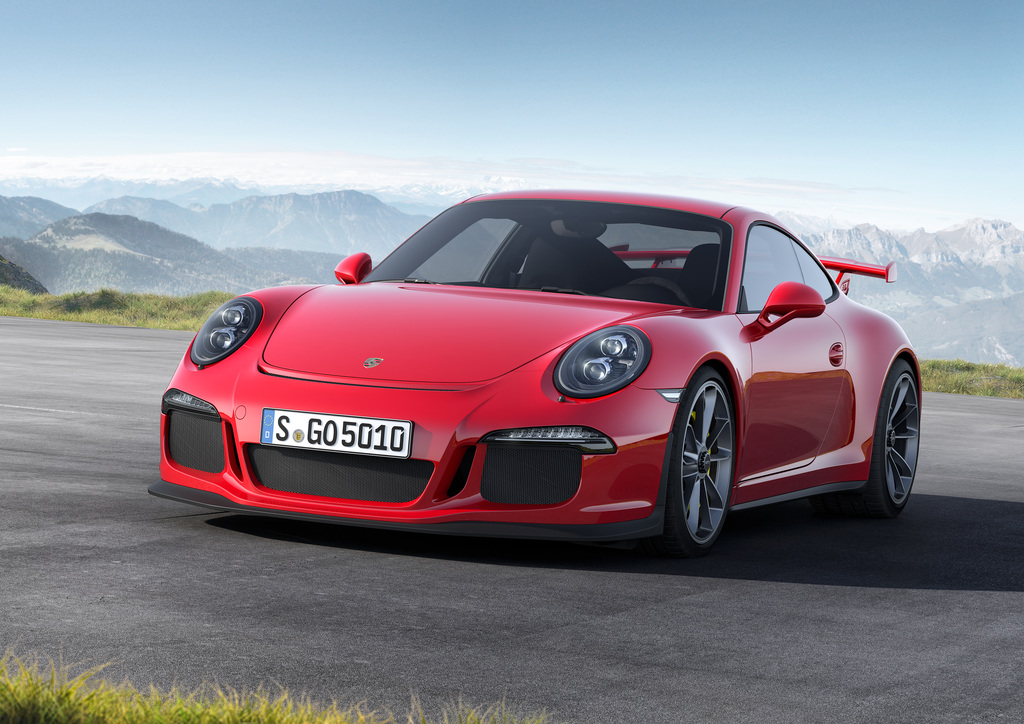

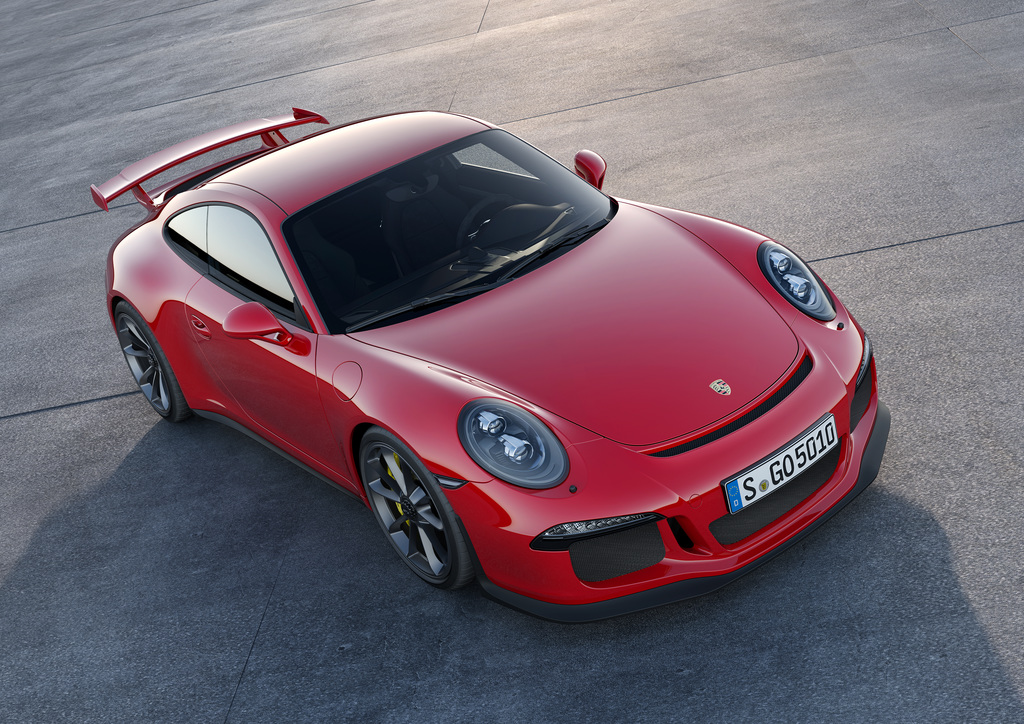
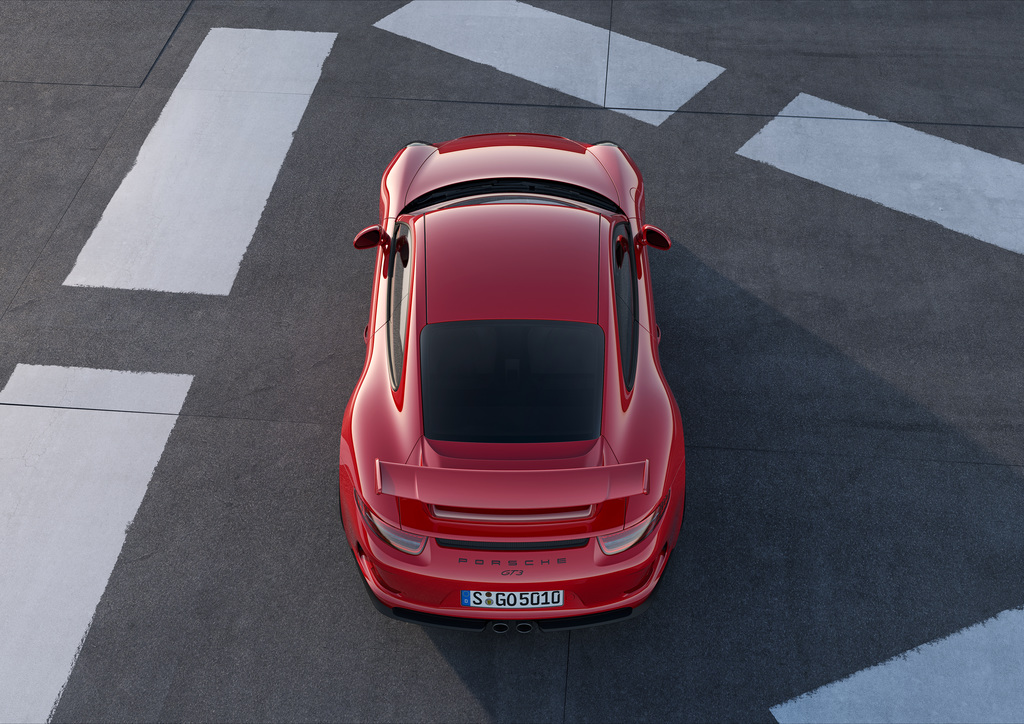
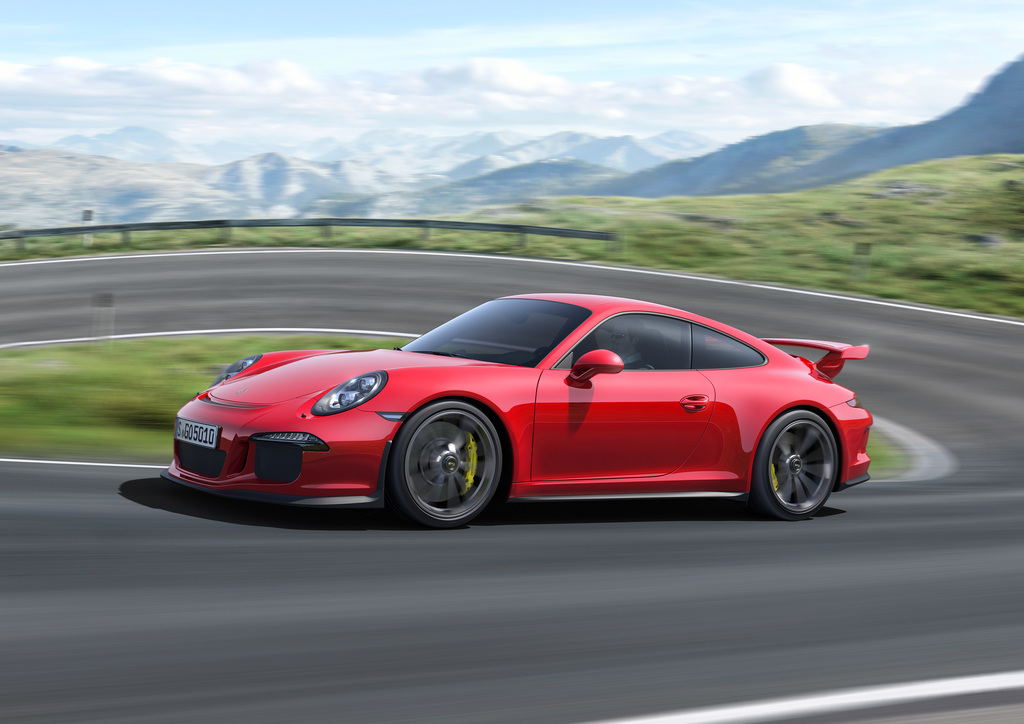
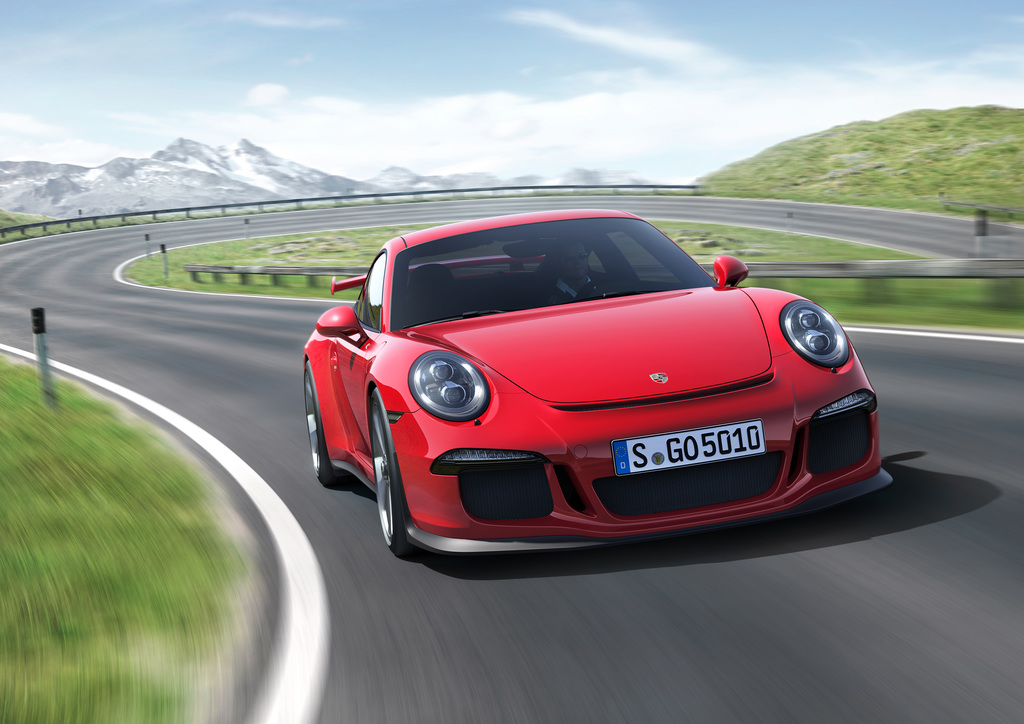

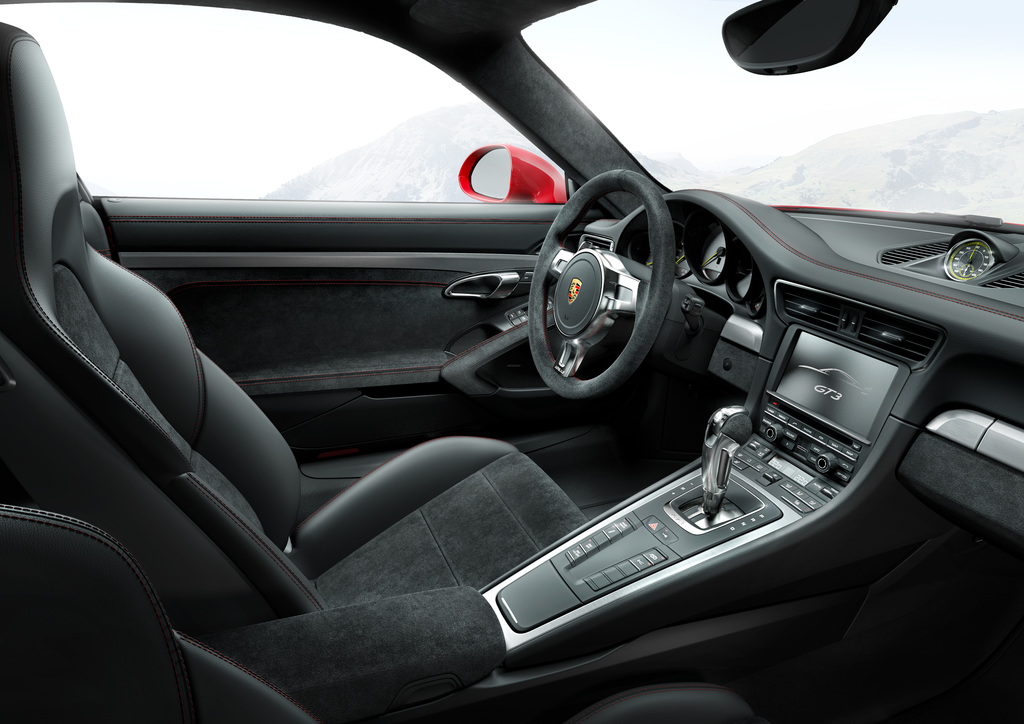
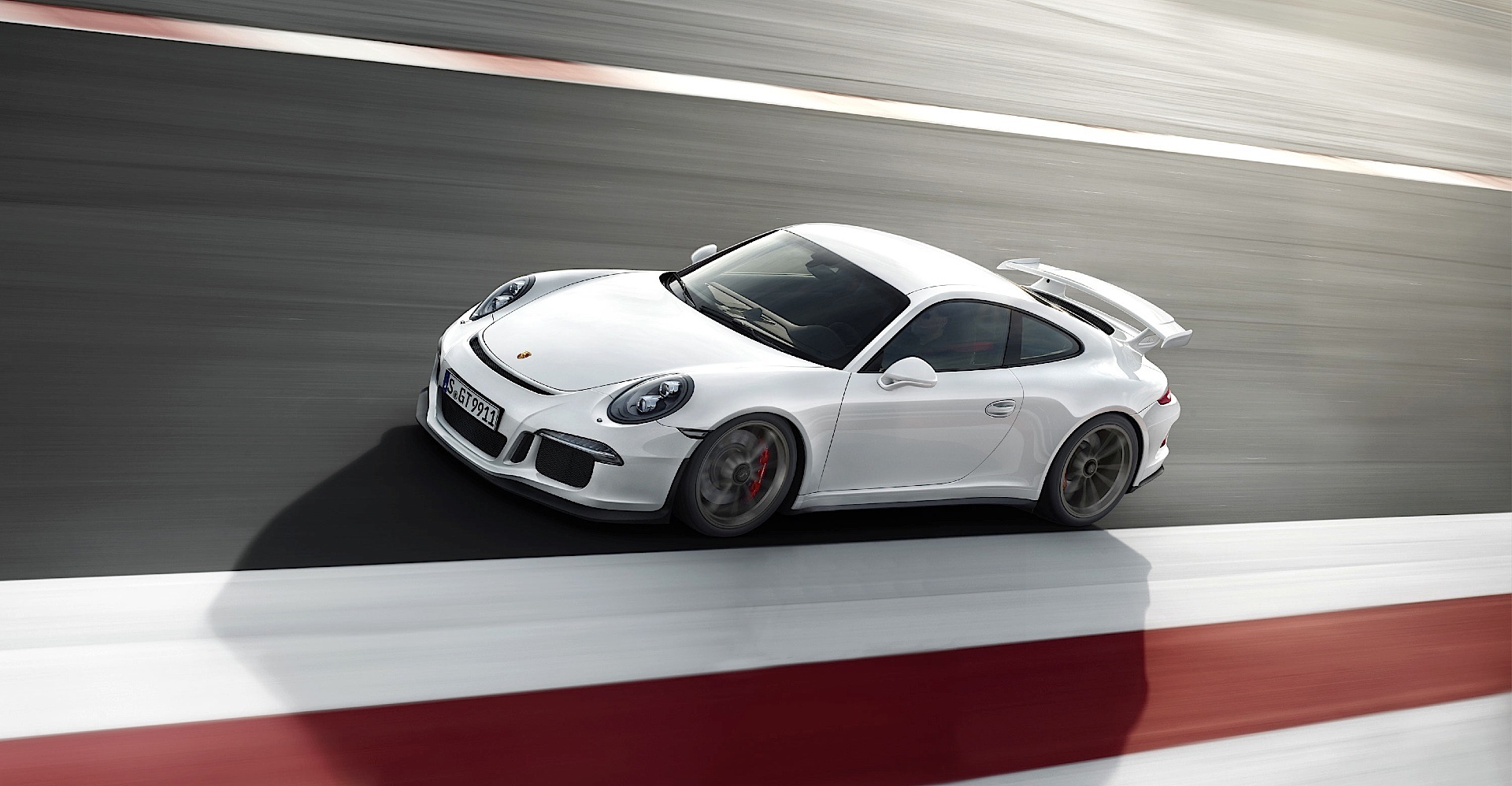
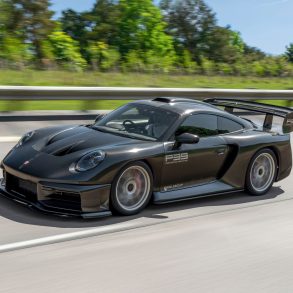



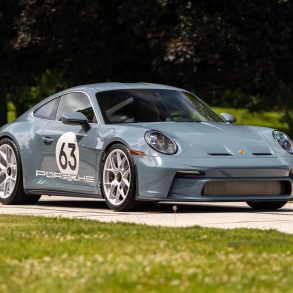




Too bad that the 991.1 gt3 (this 911) had consistent engine problems for different series of engines. The E engine caught fire, the F engine had the finger follower issue and often would need new spark plugs as well as other equipment. Even the G0 and G1 (G series) engines had problems. Only the G6 was safe to drive without additional costs although one Rennlist user reported a problem with it.
It is too bad that Porsche could not come up with an engine that had no problems for this very well thought out and badass car.
0